#Tales of our Australian mother
Explore tagged Tumblr posts
Text
It had been 87 years since nan and mum had departed, never to return, leaving behind my grandfather, who I would never meet.
My mother had never spoken to me of her feelings and I think they remained painful for her until the end.
Chris Jagger, Tales of our Australian mother.
#i loveee insights about Eva#chris jagger#mick jagger#Tales of our Australian mother#eva jagger#jagger family#the rolling stones#classic rock#old rockstar#quotes#rocknroll#rock#rock n roll#aurora australis
2 notes
·
View notes
Text
Yurlungr - Day 46
Race: Snake
Alignment: Neutral-Chaos
June 3rd, 2024
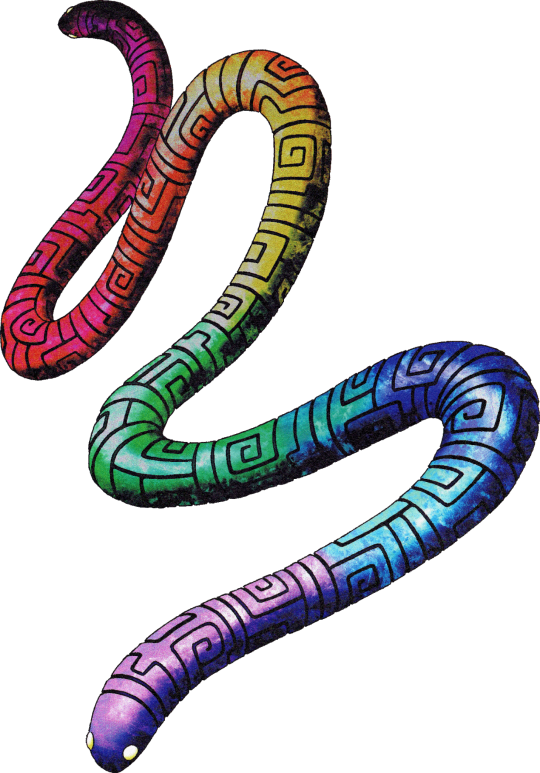
You know what the term Pride Month has if you squish it together a bit? Demon! Hell yeah, it's time to get into a serpent with all the colors of the rainbow to please our gay overlords. Please welcome the snake, the myth, one of the most famous deities in Australian mythology, and an absolute favorite demon of mine, Yurlungur! Originating from Aboriginal mythology, a criminally underrepresented mythos in several series (SMT included, unfortunately,) Yurlungur is the primary deity depicted in several breakout tales from this relatively unknown set of stories, a winding copper snake known for bringing rainfall and life in tow.
Yurlungur, better known as the Rainbow Serpent, is an incredibly important entity in Australian mythology, being an archetypical 'Mother Nature' of sorts. As its origin story goes, it was the creator of the land and sea, and could bring great prosperity- however, if one were to bother it, that prosperity would come crashing down, as it was a force of nature in more ways than one. Interestingly, Yurlungur is only one epithet of several given to the Rainbow Serpent, as several other cultures in Australia at the time gave it different names in spite of having it as one, overarching force. For instance, the Galpu clan called it 'Witij', while a similar deity typically purported to be the Rainbow Serpent in Queensland is named 'Kanmare.' Several more names make up this ranking, but given that Yurlungur is the most widespread epithet, given by the Murngin, I'll keep referring to it as that. Just keep in mind that, in further research, many sources may call it different things, so give your thanks to the fact that there were so many Aboriginal cultures out there.
According to anthropologists, the snake is heavily associated with the concept of 'The Dreaming,' an incredibly important bag of worms in Australian mythology- the idea of The Dreaming, or Dreamtime, is a romantic worldview of times before our own wherein great heroes and monsters resided, where supernatural threats were vanquished by not gods but mortal men who were simply revered as legends. During this time, it's believed, the Rainbow Serpent was most active- it gave blessings to humanity and curses to those who dared to break the law of nature, being the ultimate protector of mankind above all. Even past the time of Everywhen, however, the Serpent still lives on; a beautiful concept related to it, in my opinion, is the idea that each rainbow is simply a trail left behind in the sky as it flies from area to area.
The most prominent myth about the Serpent... isn't really one I wanna touch, frankly, given that it makes me a bit squeamish, but oh well. As the tale goes, a pair of sisters, the Wawalag sisters, to be exact, travel the land in search of civilization, as one is pregnant. Then, the one who was pregnant ends up giving birth, whereafter the blood from the agonizing process ends up trailing into the Rainbow Serpent's watering hole. Likely perturbed, the snake ends up following the scent of blood to the sisters now taking shelter in a hut, invades in the dead of night, and eats them and the newborn they were now carrying. Satisfied with its revenge, it tries to head back home... and then is bitten by an ant, the act of which makes it throw up.
This action makes the regurgitated bodies of the three turn into Arnhem Land, a term for the northern section of Australia, wherein the Serpent speaks and tries to make right for its action by helping the people who move there. Yeah. I don't know either. I think this story is meant to be a metaphor for the creation of a family, but...??? Yeah, I don't know. Sue me. That (frankly bizarre) story aside, though, the Rainbow Serpent actually does stand as a favorite in terms of Mythology for me, and it's all down to the fact that it's so unique- and almost cute.
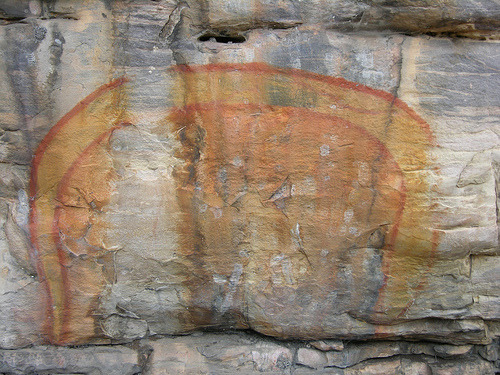
Nature deities are no small part of any tapestry or pantheon, but something about Yurlungur just tickles me. It may be its role as an embodiment of the rainbow itself, it may be just down to my love of snakes and rainbows, it may even just be down to the fact that Aboriginal folklore is underrepresented in so many faucets, but the Rainbow Serpent is a favorite deity of mine even in the star-studded halls of gods. It has a unique purpose as a creator god, a mother god, a nature god, the lord of the rain and weather, and being a snake, all the while having a cool sheen and an interesting look. I love Yurlungur to bits. All of that aside, though, how is it represented in SMT?
I love it. Full stop. Thanks for readi- no, no, I'm joking, but this design is easily in my top 10. Not only is it rainbow, not only is it adorable, but it's accurate and unique! It brings something entirely new to the table while still being a fantastic representation of the Rainbow Serpent itself, as the etching and patterns on it give it a vibe that makes it feel uniquely spiritual, in a way. It also makes the snake stand out among its peers. This is how you do a god-snake design, Quetzalcoatl! It's a perfect rainbow to start off Pride Month, and I hope you all enjoy this demon as much as I do.
Overall, while the mythology surrounding Yurlungur is a bit... strange? It has a beautiful design, represents an incredibly romantic ideal, and is definitely deserving of being the demon of the day.
39 notes
·
View notes
Text
A Wednesday Christmas Carol: A Wednesday Addams Fanfiction Tale

Summary: In the days of Christmas Future, Wednesday and Enid are married with two teenage daughters. However, despite having a happier life now, Wednesday hates Christmas with a passion... which Enid and their daughters try to change...
*I wrote this story last year, but am sharing again for the holiday season. Click any of the links below to read the story, or just click "keep reading". Lots of humor and heart in this tale.
Wattpad Link, Archive of Our Own Link, Fanfiction.net Link
Wednesday Addams and Enid Sinclair. They were a duo that shouldn't have worked... but they did... and somehow their relationship resulted in marriage. Now, Wednesday and Enid work at their old school: Nevermore Academy as teachers, raising up an entire new generation; including their own twin seventeen year old daughters: Harmony and Ana. Harmony, who carries both of her mother's special abilities, continues to grow and explore the world with her girlfriend Megan. Ana meanwhile... is a different story...
****
One morning on Christmas Eve: a fresh layer of snow was laying everywhere, while the sound of Christmas carolers could be heard from a faraway distance. Harmony and Ana Addams were walking through the park together wearing winter clothes, as they were looking around at the scenery. Harmony had a small smile on her face as she said, "Wow. The town has never looked this beautiful around Christmas before. I wish Megan was here to see it." As Ana also took in the scenery, she said, "Yeah, but I think it's nice she decided to spend her Christmas with her extended family this year. It means we get one more Christmas with just the two of us and mom together before you get married." Harmony suddenly had an overwhelmed look on her face as she said, "Wow. You're right. It's also dawned on me... me and Megan need to start making some plan on what our wedding will look like." Ana smirked as she said, "Well if you want, I can officiate the wedding." A confused looking Harmony then said, "What!? Since when can you do that?" Ana continued to walk as she casually said, "Since I became an honorary priest in the catholic church. The Pope owed me a favor after I saved him from some Australian Polar Bears that were trying to swap brains with him." Harmony looked very confused for a moment... but then casually said, "Of course you did. So anyway, where's that cat of yours Ana?" As Ana turned her head in multiple directions, she said, "Yeah, I've been keeping my eye out for him, and... Wait. Hold on."
Ana then moved towards a tree where she heard meowing noises. Harmony followed, and eventually the two sisters saw behind a tree were Ana's cat and a white female cat making lovely meowing sounds at each other while they gently rubbed their heads against one another. A smiling Harmony put her hands together as she said, "Aww. How cute!" However Ana looked nervous as she said, "Oh no. Tell me that isn't the cat that belongs to..." Then Ana heard a male teenage voice yell, "Princess Snuggles!" Ana turned her head with a disgusted face, and saw a teenage boy walking towards the scene. Ana glared forward as she said, "Duncan." The teenage boy Duncan immediately saw what the two cats were doing, and quickly yelled, "Princess Snuggles, get away from that cat. He is the enemy!" Ana meanwhile took a big deep breath, and then looked straight at Duncan as she said, "Look Duncan. We may not like each other, but our two cats obviously do. So in the spirit of Christmas, lets try to make a little peace on Earth and try to get along for the sake of the love between our pets that we so love. What do you say?"
Duncan stood silent... for two seconds, before he angerly yelled, "No! You're a freak, and so is your cat!" Ana rolled her eyes and said, "So we're gonna do this the hard away." Then Ana immediately took out a taser and shoved it into Duncan's chest shocking him very hard. Duncan then fell to the ground hurt, as Ana casually said, "Okay Stormageddon the Conqueror. Lets find a nice fancy restaurant for you and Princess Snuggles to dine at." Then suddenly the sound of an explosion nearby was heard. A concerned Harmony then asked, "What was that?" Ana grinned as she said, "I don't know... but lets find out. Stormageddon the Conqueror, enjoy your date with Princess Snuggles. There's a great cat-friendly Italian place nearby you should try. We'll pick you up around six." Harmony and Ana then began to run towards the sound of the explosion as Harmony said, "It's a good thing mom and mother told us to take a long walk from the house and get some exercise today. Otherwise we might have not heard that explosion." Ana rolled her eyes as she said, "Oh, I'm pretty sure mother and mom didn't want us to take a long walk because they were concerned about our needs."
****
In the family home, Wednesday used her hands to pin Enid's shoulders to the wall of the bathroom. A smiling but slightly nervous Enid said, "Wednesday, what if the girls come home while we're in the middle of..." Wednesday then suddenly covered Enid's mouth with one hand as she said, "Silence. I sent them on a long walk. We'll have time." Wednesday then quickly pulled off her black dress as she kept a straight face, while Enid had great excitement on her face as she pulled off her own clothes. Wednesday then pulled off her underwear, and began to turn on the nearby shower. Meanwhile as Enid pulled off her underwear, she began to look confused as she said, "But why are we doing this around 11am? You usually prefer to have sex either early in the morning to help stimulate your senses, or late in the day to help relieve your stress levels. Getting hot and horny right before noon isn't normal for you." A now completely naked Wednesday turned to look at Enid as she said, "Enid, your questions shall only hinder this sexual encounter." Then Wednesday suddenly put on a pair of fake cat ears as she kept a very straight face while saying, "Now be a good puppy and obey your feline master." Enid's eyes suddenly lit up as he said, "My God, what is it about those cat ears that turns me on..."
****
Harmony and Ana were running through the woods, as Harmony yelled, "Hey. I think I see smoke. I think something crashed." A curious Ana then yelled, "I think we initially misjudged where it landed. It seems to be actually pretty close to our house." Then Harmony and Ana ran towards a smokey crater that wasn't too far from their home. Then as Harmony and Ana got close, the smoke began to disappear. Then within just a moment, Harmony and Ana realized at the center of the crater was a large red sled attached to several reindeer. Then the two teenage girls realized that sitting in the sled was a large bearded man in a red suit. A very confused and freaked out looking Ana then said, "Santa Clause?" An equally confused and freaked out Harmony then said, "What is going on here... and why did this happen so close to our house?"
****
Inside of the shower, Wednesday was in the middle of kissing Enid. Enid was very much enjoying herself as she said, "Mmm. Yes Wednesday. Yes, this is amazing. Although... do you smell smoke from outside? Also, did I hear a crashing sound a few minutes ago?" A nervous looking Wednesday then quickly got on her knees and brought her face to between Enid's legs. Out of instinct, Enid immediately said, "Ohhh! Yes Wednesday!"
****
Harmony and Ana walked carefully towards the red sled where Santa Clause was getting his bearings. Harmony then stood unsure of what to do as she said, "Hello. Who are you?" Santa smirked as he said, "Well who do you think I am? I'm Santa Clause. I was just about to begin delivering my presents to all the girls and boys around the world before my sled got brought down." A very confused Ana then stepped forward as she said, "Hold on. This doesn't make any sense. Santa Clause isn't real." Santa chuckled a bit, and then said, "Well where do you think children all over the world get their presents every year?" Harmony had a practical tone to her voice as she said, "From all the parents of the world."
Santa laughed for a moment, and then said, "You two actually believe that parents every year decide to give their kids more presents, after already losing tons of money on birthdays!? That's ridiculous! Besides, you think your mother: Wednesday Addams would have allowed you girls to receive all those colorful toys you received growing up? Not a chance! Besides, that goth gal has had it out for me for years. I've always had to be real careful delivering gifts to this house the night before Christmas every year. Now then, I wonder why I crashed so suddenly?" A look of clarity went across Harmony's face as she said, "Hold on. Our mother for years has had it out for you? I don't think your crash here was accidental."
****
In the bathroom, both Wednesday and Enid were now sitting up on the shower floor as a happy Enid said, "Mmm. That was amazing Wednesday." Wednesday then looked at a nearby clock in the bathroom as she said, "Indeed. Especially since the task is now done." Enid suddenly sat up straight as she glared at Wednesday while saying, "What task?" Wednesday suddenly looked a bit nervous as she said, "I mean... the task which was our sexual intercourse." Enid continued to glare at Wednesday while saying, "Oh no Wednesday Addams. You never refer to sex as merely a task. You were up to something just now. But since we were busy going at it in the shower, it had to be something you already laid out... and didn't want me to know!" Enid then quickly got up and began to put her clothes back on. Wednesday then quickly got up and began to put her own clothes back on as well. Enid then rushed over to the nearest window as she said, "Hold on! Is that Santa Clause outside our house!?"
****
Outside the house: Harmony and Ana were helping Santa Clause repair his sled. Ana smiled as she said, "Okay Santa. I updated your GPS, and gave all your reindeer some amazing protein shakes. You're all good to go." Then suddenly Wednesday came running out of the house holding a sword forward as she yelled with an enraged face: "Your reign of jolly ends now Saint Nick!" Enid suddenly ran out of the house and held Wednesday back as she loudly said, "Whoa! What the heck is going on!?" Santa rolled his eyes as he said, "Let me guess. You are the one that sent that missile up to make me crash." A confused Harmony then said, "Wait mother. You know Santa Clause?"
As Wednesday struggled to get free from Enid, she bitterly said, "Only by reputation. Santa Clause is one of the oldest outcasts in the world that ever attended Nevermore Academy. He had unique psychic abilities that allowed him to manipulate time and space to move across great distances within short periods, such as the entire Earth on Christmas Eve. However, rather than use his special abilities for something more productive, he's instead used his powers to perpetuate happiness around the holiday season. But after years of trying to stop his reign of good tidings to all, his time ends now!" Then Wednesday quickly broke free from Enid, and ran at Santa Clause with her sword out. However the magical reindeer quickly flew into the sky, and pulled Santa and his sled up with them. Santa laughed as he said, "Better luck next year Mrs Addams!" Once Santa and his sled were out of sight: Wednesday simply stood in front of the house, glaring up at the sky as she clenched her fists.
****
A short time later, Wednesday and Enid were sitting next to each other on the couch in their living room. Wednesday sat with anger on her face. Enid meanwhile starred at Wednesday with shock and disappointment as she said, "You tried to kill Santa with a missile, and tried to distract me with sex so I wouldn't stop you!? Wednesday, do you realize how this must make me feel!?" Wednesday kept a straight face as she said, "Terrible... because I wasn't able to get the job done." Enid gave a frustrating moaning noise as she covered her face for a moment. Then Enid turned to look at Wednesday as she said, "Wednesday, every year you always try to ruin Christmas for everyone! You try to convince all the volunteers from the Salvation Army outside the grocery store that their work has inconsequential impact on improving society, you're the only person in existence that's protested against the Angel Tree project because you believe none of their funding should be spent on toys due to their short span of use in a child's life, you regularly try to dump hot oil on any Christmas carolers that come to our door..." Wednesday interrupted Enid as she said, "They had it coming, considering they chose not to need heed the warning signs I put up around our property that explained quite clearly that trespassers and solicitors will be punished."
Enid grunted in frustration for a second, but then said, "The point is - you keep trying to ruin Christmas every year for all of us, and it's gone too far now. Look... I understood when I married you that we weren't going to have the kind of family I had while growing up. I understood we couldn't have a garden in the front of the house with flowers. I understood that you would train our children in the basics of assassination. I understood that Valentine's Day would forever involve corpses for some reason. But I don't get why we can never simply celebrate Christmas in this house. You've never even let me bring a dead tree in here for the holiday!" Wednesday kept a straight face as she said, "All Christmas trees are technically dead as soon as they're chopped down." Enid looked more angry as she said, "That's not the point! You never let me make Christmas cookies for the family, you never let me send out Christmas cards to the relatives, you never let me play Christmas music on the radio..." Wednesday interrupted Enid as she bitterly said, "If Mariah Carey still hasn't gotten the individual she wishes for every Christmas through song, then perhaps she should try a different tactic."
Enid tried to remain calm as she said, "Wednesday... you never even let our girls watch Christmas movies growing up." Wednesday kept a straight face as she said, "If you forgot, I did allow Harmony and Ana to watch one festive movie when they were five years old." Enid's eyes got wide with frustration as she said, "You showed them How the Grinch Stole Christmas, but then stopped the movie after the Grinch stole all the presents, telling our girls that was the movie's happy ending!" Wednesday kept a calm face as she said, "As I recall, doing that was a compromise I made with you. In addition, I still have accepted our long standing compromise that you and the girls shall exchange gifts and enjoy them on the morning of every December 25th."
Enid gave a sad sigh, and then said, "But you're never there with us opening presents Wednesday. You always spend every Christmas morning off doing whatever it is you do alone. Christmas is supposed to be about family!" Wednesday then glared at Enid once more as she said, "On the contrary, I thought Christmas was about celebrating the birth of an individual that was created to become a sacrifice due the declining quality of humanity." Enid looked a little more frustrated again, as she said, "But it's much more than that Wednesday. Look... instead of trying to destroy the holiday this year, you should really try embracing the Christmas spirit for once, and experience everything fun the season has to offer." Wednesday then glared at Enid while saying, "What? And turn our home into something akin of a cliche TV Christmas special?" Enid suddenly had an excited look in her eyes as she said, "Actually... that sounds like a lot of fun..."
Enid's Imagination...
On a large TV studio that was made to look like a living room, an announcer was heard saying to a large studio audience: "It's the Wenclair Family Christmas Special! Starring Enid and Wednesday Addams, along with their daughters: Harmony Addams, and Ana Addams. Also featuring special appearances by our planet's new warlord: Stormageddon the Conqueror. Plus, special warm family friendly Christmas songs that will be performed by KISS, the Sex Pistols, and world famous signer: John Lennon - who we brought back from the dead thanks to tonight's sponsor... the demons of hell! Plus, one super special surprise guest will be showing up at an unexpected moment, so don't touch that dial! And now here are your hosts... Enid and Wednesday!"
A smiling Enid then walked onto the TV set wearing a long white dress, while a grumpy looking Wednesday also walked onto the set wearing a long black dress. As Enid happily looked at the camera, she said, "Hello everyone. Welcome to our wonderful home! My name is Enid, and this is my wonderful wife: Wednesday! Say hello to the people at home Wednesday!" Wednesday then glared at one of the cameras as she said, "You all live meaningless lives if you can only have an ideal Christmas through vicariously experiencing it through this hollow performance." The studio audience then laughed very loudly.
A smiling Enid meanwhile continued to look at the camera as she said, "Well tonight we plan to have lots of guests come over, but I'm worried they won't make it due to all the unexpected snow that's coming down outside." Wednesday meanwhile continued to keep a straight face while saying, "A natural side effect of global warming, which our countries' leaders still seem to ignore." Then studio audience then immediately laughed loudly again. Enid meanwhile kept a happy face as she said, "Well I'm so excited to see what presents I'll get for Christmas this year. What are you hoping for Wednesday?" Wednesday gave a deadly glare at the camera as she said, "A guillotine... that I plan to use on whoever came up with the idea for this special." Then a grinning Enid said, "Well, me... I want... a hula-hoop!" The studio audience then happily laughed again.
Then suddenly Harmony and Ana appeared walking down a set of stairs, while Harmony said, "Good evening everyone!" The crowd then applauded and cheered loudly as Harmony and Ana came to the center of the stage. Enid then walked over to the girls as she said, "Hold on Harmony. You put your dress on backwards. Were you having 'intimate relations' with your girlfriend Megan just a minute ago, and put your clothes accidentally on backwards when you rushed down knowing the show was about to start?" Harmony gave a goofy smile as she said, "Maybe..." The studio audience laughed, as a grinning Enid said, "Holy guacamole Harmony. You sure are a handful. And Ana, I heard the state of Wyoming just got turned into jello. Did you cause that with another one of your wacky experiments?" Ana then also gave a goofy smile as she said, "Maybe..." The studio audience laughed once more, as a grinning Enid said, "Holy guacamole Ana. You sure are a handful." Meanwhile Wednesday looked angry as she said, "There is certainly nothing 'holy' about this experience."
Suddenly the doorbell rang, and an excited Enid said, "Oh my gosh everyone. That must be our super special surprise guest. Lets see who we're going to greet at the door." Enid opened the door, and then suddenly walking into the house was... Chewbacca as the classic Star Wars theme song played on speakers around him. Chewbacca then made many loud noises, as subtitles appeared below him saying: "It's not Christmas without Chewbacca!" The entire studio audience immediately cheered and clapped very loudly. A very happy Enid hugged Chewbacca as she said, "Chewy, it's great to see you. What would you like to do with us tonight?" Chewbacca then made several loud noises. Then a super excited Enid said, "You want us to go visit your family on your home planet and celebrate Life Day with them? Okay! That sounds like a perfect way to enjoy the holidays!"
Enid looked up with happy starry eyes, as an angry looking Wednesday said, "Enid, that's the most ridiculous fantasy that's ever been conjured in the history of existence." A smiling Enid then turned to look at Wednesday as she said, "But that's the thing Wednesday. Christmas is a time where you get to do silly ridiculous things that are reminiscent of childhood. It's a season to think about happy memories and embrace good times. I mean your parents told me that you actually did celebrate Christmas in your home when you were young, and loved getting gifts from Santa. You should recreate some of your favorite childhood memories with our girls before it's too late." Wednesday then stood up and angerly said, "It is a waste of time to re-create a childhood that can never be lived again. It is better to dwell on preparing for a future that is inevitable, versus dealing with the guaranteed failure of reconstructing the past." Then Wednesday quickly walked out of the room, while Enid sat with a worried look on her face.
****
An hour later: Enid, Harmony, and Ana were sitting in the kitchen eating Christmas tree shaped cookies (while Ana's cat also sat on the table eating Christmas tree shaped cat food). A smiling Ana then said, "Mmm. Mom, you make the best Christmas cookies!" A panicked looking Enid then said, "Shh! I told you... this tradition of us eating cookies on Christmas Eve is supposed to be a secret. Your mother cannot know!" A curious Harmony then said, "Mom, what's the deal with mother always trying to be so anti-Christmas? It's like she wishes the holiday didn't exist." Enid sighed, and then said, "I've been married to that woman for over seventeen years, and there are still some things I don't understand about her. I mean... your mother has certainly evolved and become much more accepting of things she never would have tolerated back when we first met. However when it comes to Christmas... she's always been a real Scrooge."
Then Ana's cat lifted it's head with a profound look on his face, and then said "Rowr." Then a wide eyed and excited Ana said, "That's a brilliant idea Stormageddon the Conqueror! We gotta Scrooge mother!" A very confused looking Enid then said, "Excuse me?" An eager looking Ana then stood up as she said, "A Christmas Carol by Charles Dickens. We all know the story. It's famous because of how Scrooge's experiences with seeing his past, present, and future changed his outlook on Christmas. So we just gotta re-create that experience with mother, and then her outlook on Christmas will change." A skeptical looking Harmony then said, "Yeah... but how are we gonna pull that off?" Then Ana got out her phone as she said, "Don't worry. I know a guy in the Seance Society that owes me a favor."
****
That evening, Enid was walking with Wednesday down to the basement of the home. A confused looking Wednesday then said, "I am confused as to why we going down to my private area of the house together." Then Wednesday eventually saw Harmony, Ana, and Ana's cat were sitting around a large circle on the floor that had strange carvings and candles inside of it. Wednesday glared at everyone as she said, "If you are trying to force the deceased to appear before you, don't bother. I've been trying to pull that off for years and have consistently failed." Then a smiling Enid held Wednesday's hand as she said, "Oh, we're not trying to call upon the spirits of the dearly departed Wednesday. We're trying to call upon the spirits that always have been amongst the Earth, such as... the spirits of Christmas!" A wide eyed and horrified Wednesday then said, "No! You don't mean..."
Then an excited Harmony said, "Come on mother. You've always wanted me to get more in touch with my psychic abilities. So tonight I am through a special book Ana's friend gave us." Wednesday then began to walk away as she said, "No. I refuse to be a pawn in your twisted scheme." Then a grinning Ana said, "Fine. But if this whole conjuring of spirits goes wrong, it would really stink to not have an expert on these matters around to fix everything. I mean the last thing we'd want is the spirits of Christmas to accidentally get trapped in our home for all eternity." Wednesday paused for a moment... took a deep breath... and then sat down in a chair with an angry look on her face while saying, "I longed for the day my children would be as manipulative as me... but I did not foresee it would be for such horrific goals."
Harmony smiled as she held out a book over the strange circle on the floor. Harmony then focused her mind as she said, "I, Harmony Addams, member of the Addams Family clan, descendant of Goody Addams, call upon the spirits of Christmas past, present, and future to show themselves to us tonight. I now recite the ancient chant to bring forth these spirits. Venite ad nos magni spiritus Natalis Domini. Tuam sapientiam reverenter petimus. Vosmetipsos ostendite! Appare! Appare! Fa la, la, la, la, la, la, la, la!" Then suddenly a blue mist began to spin around the room. A curious Enid then said, "What's going on?" Suddenly Harmony's body began to glow as a blue energy came out of the floor and into her body. Then the mist disappeared. A worried Enid then walked towards Harmony as she said, "Harmony... are you okay?"
Harmony then turned to look at everyone with a big smile as she said, "Yes. Harmony. I am her... and yet I am not her." A confused Ana then said, "Wait. What's going on?" Harmony grinned as she said, "I'm the spirit of Christmas past. I have temporarily possessed the body of this girl. I have all her memories and personality... but also my own. Do not worry though. When I am done here, I will leave Harmony's body, and then the spirits of Christmas present and future will temporarily possess two other bodies." An excited Enid then said, "Okay. So... Spirit of Christmas Past... we're trying to help my wife Wednesday here see Christmas throughout the span of her existence. Think you and the other spirits could help us?" A smiling Harmony then said, "Ah, yes. Harmony has many memories of how her mother feels towards this season. Hmm. Well... yes! Me and my fellow spirits will indeed help your entire family see things more clearly tonight. Now, first things first... I shall show you events from long ago that you all would benefit to see." Then Harmony waved her arms around, and suddenly everyone in the room disappeared.
Wednesday, Enid, Harmony, Ana, and Ana's cat all suddenly appeared in the old Addams Family home. An excited Enid then said, "Wow Wednesday. We're in your childhood home!" A smiling Harmony then said, "Yes. Nearly thirty years ago. Don't worry though. We haven't traveled through time. We're simply witnessing the past as unseen observers. Now behold..." Then everyone saw in the living room of the old Addams Family home: Gomez, Morticia, Fester, young Pugsley, and young Wednesday were sitting around a Christmas tree. The tree has no green pines, but still had many decorations on it, along with many presents surrounding it. An excited young Pugsley then held up some bows and arrows as he said, "Wow! My own archery set! I can't wait to use this!" Then Fester happily said, "How about we go outside and you can practice hitting apples off the top of my head?" An excited young Pugsley then said, "Wow. Can I father?" A happy Gomez then said, "Of course Pugsley. But be careful. If you hit Uncle Fester by accident, that will ruin the arrow." Then as Pugsley and Fester left the room, an excited young Wednesday then jumped up as she said, "Mother! Father! Look! Santa gave me a new Marie Antoinette doll, and a new guillotine that cuts heads much faster! I can't wait till I see how quick I can chop this dolls' head off!" Meanwhile as Enid watched, she held Wednesday's hand while saying, "Look Wednesday! Little you is so happy on Christmas! See how much joy this holiday used to give you." Wednesday however had an angry look on her face... but also looked ashamed as she said, "We all have a past."
Then everyone turned their heads, as they saw the door to the home open. Then suddenly Wednesday's grandmother appeared walking into the home carrying a bag as she said, "Merry Christmas everyone!" Then a smiling young Wednesday ran towards her grandmother as she yelled, "Grandma!" Then young Wednesday hugged her grandmother tightly. Wednesday's grandmother made a warm smile as she said, "How are you doing my favorite grand-child?" A smiling young Wednesday then said, "I'm okay. But grandma, why do you say I'm your favorite grand-child? Mother and father say you love me and Pugsley equally." Wednesday's grandmother chuckled as she said, "Aw, come on. We all know that's a bunch of phony baloney. Every parent and grandparent has a favorite. Just be grateful it's you. So anyway, let me see that mouth of yours. How's it looking?" A smiling young Wednesday pointed to her mouth as she said, "I've lost three baby teeth in the last four weeks. See the holes in my mouth!" Wednesday's grandmother looked amazed as she said, "Wow Wednesday! You look uglier than ever before! I'm so proud to call you my grand-daughter. Anyway, it looks like Santa accidentally left a present for you in my room. So here's your extra Christmas gift." Then Wednesday's grandmother took out of her bag: an old record player. Young Wednesday's eyes lit up as she said, "Wow! It looks so old and gloomy! Can I play a song and dance to it?" Wednesday's grandmother chuckled as she said, "Sure. But you'll need a dance partner. Not me. I'm too old."
Then Lurch suddenly walked into the room as he said, "Uuuuuuuuh." Then an excited young Wednesday immediately jumped up and said, "Hey Lurch! Dance with me!" Then young Wednesday immediately started playing a dance song on the record player. Young Wednesday then walked over to Lurch as she said, "This is the latest. It's called the droop." Then young Wednesday started shaking her legs while waving her arms back and forth. Lurch stood looking uncertain of what to do, while Morticia (who had been watching everything) said, "Come now Lurch. I know there's that zombie girl living down the street that you've been wanting to impress. I'm sure if you learned a few dance moves, you'd give her one more reason to not return to the grave." Then a young Wednesday happily said, "Yeah. I think that zombie girl down the street is a swinger." Lurch looked confused as he said, "Swinger?" As young Wednesday continued to dance, she said, "You don't want her to think you're square do ya?" Lurch then quickly turned his head. Then an excited young Wednesday said, "Then if you learn how to dance well, she'll think you're boss." Lurch looked confused again as he said, "Boss?" A happy young Wednesday continued to dance as she said, "Neat. Groovy. Come on. Try it." Then Lurch began to attempt to copy little Wednesday's dance moves.
Meanwhile: Wednesday, Enid, Harmony, and Ana had been watching the entire scene. Everyone tried to keep a straight face... but then suddenly Enid, Harmony, and Ana's mouths burst open as they began to laugh hysterically. As tears came out of her eyes, Ana said, "Really mother? Swinger? Neat? Groovy? What century did you grow up in?" As Enid chuckled, she said, "Be nice Ana. I mean... you don't want your mother to think you're square do ya?" Then Enid fell down laughing more. Meanwhile Ana's cat ran over to the scene of young Wednesday and Lurch dancing, and then began to dance with his little paws beside them. Then Enid and Ana joined in as they began to mimic young Wednesday's dance moves. Meanwhile Wednesday glared at the scene for a moment... and then glanced at Harmony as she said, "Be honest with me. You're really the spirit of Christmas Torture, aren't you?"
Meanwhile little Wednesday ran over to her grandmother as she said, "Thank you for the record player grandma!" Then Wednesday's grandmother grinned as she said, "Oh, but there's more. I also got one more surprise gift. How would you like your very own, straight from the Tennessee prison system, electric chair!" Then Wednesday's grandmother pulled a curtain nearby, and showed hiding behind the curtain was an old rusty electric chair. A super happy Wednesday jumped up and down as she yelled, "Oh my gosh! Oh my gosh! My own electric chair!" Then young Wednesday immediately hugged her grandmother as she said, "Thank you so much! I love you grandma!" Wednesday's grandmother smiled while hugging Wednesday as she said, "I love you too Wednesday. So... how about we find your brother and test this on him." A young Wednesday grinned as she said, "Neat."
Meanwhile: Wednesday, Enid, Harmony, and Ana were still watching. As Enid put a hand on Wednesday's shoulder, she said, "Just look how happy Christmas used to make you Wednesday. Doesn't this change how feel about it now?" Wednesday then crossed her arms, and glared at Enid while saying, "No." Then Harmony smiled as she said, "Well, there's still more to see... but not with me. The rest of your journey will be led by my fellow spirits. Now... we depart." Then a blue mist began to surround the group, and suddenly they disappeared.
In a blue flash: Wednesday, Enid, Harmony, Ana, and Ana's cat all appeared in the basement of their home again. As Wednesday looked around, she sat back down in a chair while saying, "Well this is at least some improvement." Ana then walked towards Harmony as she said, "Harmony... are you back to normal?" Harmony nodded her head as she said, "Yeah. The spirit of Christmas past has left my body. But... where is the spirit of Christmas present?" Then Ana looked puzzled as she said, "Well it's not with me... and it's not with mother. So that means..." Then everyone turned their heads and looked at a grinning Enid... who then waved her hands and said, "What's up party people! I'm the spirit of Christmas present... with a big dash of Enid as well! So... who wants some gifts?" Then Enid snapped her fingers, and suddenly several wrapped gifts magically appeared in the room. A confused Harmony then said, "What's up with these?" Enid raised one eyebrow as she said, "Well I am the spirit of Christmas Present. It's a pun. Get it? Come on everyone. Check out what's inside."
Harmony then opened one gift as she said, "Let see what's in here. Hey! There are a few Christmas movie DVD's in here." Then Ana opened another gift as she said, "Yeah, along with some old Christmas music CD's. Hold on. These are copies of songs and movies we listen to and watch every Christmas when mother is gone from the house all day." Then Enid glanced at Wednesday as she said, "Come on Wednesday. Time for everyone to see what's inside your present." Then Wednesday reluctantly walked over and opened one gift before her... only for everyone to see nothing inside. A confused looking Ana then said, "I don't get it. Why is mother's present empty?" Then a bitter looking Wednesday said, "Because this is all Christmas means to me now... nothing."
Then Wednesday tore up the empty box, and threw it to the ground. Suddenly all of reality around the women came apart, and everyone saw themselves now standing in a black void. A nervous Harmony then asked, "Where are we now?" Enid kept calm as she said, "You're looking into a manifestation of what Wednesday's soul is always like on Christmas. A black void that contains nothing." Then a confused Ana asked, "But why?" A confused looking Harmony then said, "It doesn't have to be this way. Mother, before this black void appeared - you saw all the fun stuff that is always part of Christmas for the rest of the family. Don't you want to be part of that? Christmas doesn't have to be full of emptiness." Then Wednesday glared at everyone as she said, "All of you make those frivolous things part of your Christmas. But not I! End this display now spirit!" Enid sighed for a moment, and then said, "As you wish." Then a blue mist began to surround the group, and suddenly they disappeared.
In a blue flash: Wednesday, Enid, Harmony, Ana, and Ana's cat all appeared in the basement of their home again. As Enid looked around she said, "Whoa. Okay, that was weird. But I'm me again. So now I guess we're about to be visited by the spirit of Christmas Future." Wednesday rolled her eyes as she said, "This will only be remotely enjoyable if he actually chooses to show up in his traditional grim form." Then as Ana looked around she said, "Well I still feel like myself." Then a confused looking Harmony said, "Yeah. And I'm definitely still me too. But if the spirit of Christmas Future didn't possess mother, mom, me, or Ana... who did he possess?" Then suddenly the four women heard a raspy male voice say, "Well it's about time I finally get to voice my feelings to all of you doll faces." Ana suddenly had a very surprised look on her face as she said, "No way!" Then everyone turned their heads and saw Ana's cat sitting on top of a table smirking as he said, "How do you do ladies? I'm the Spirit of Christmas Future, with a mix of your feline friend's personality and memories. And by the way, the part of me that is your cool cat has so many things he's wanted to say to the lot of you dames for ages."
A super excited Ana then exclaimed, "Stormageddon the Conqueror! This is the coolest thing ever! I can't believe my best friend is now finally talking to me. This is unreal." Ana's cat smiled as he said, "Well, hey. I'm not crazy about reality, but it's still the only place to get a decent meal. But thanks for letting me know I'm your best friend Ana. I mean outside of a cat, a book is a girls' best friend. Inside of a cat though, it's too dark to read." Then a confused looking Enid asked, "What's with the way you're talking? You sound like you're from a black and white movie, or some old comic strip." Then Ana's cat raised one eyebrow as he said, "Hey. If you want to see a comic strip, you should see me in the shower." Then a curious Harmony asked, "So since you can talk now... can you tell us the full details on where you as a cat originally came from?" Ana's cat then held up one paw as he said, "Hey. The part of me that is the Spirit of Christmas Future isn't allowed to tell you anything about your cat's past. Only what he's feeling in the here and now. Those are my principles; and if you don't like them... well I have others."
Then Enid cleared her throat for a second, and then said, "Well... the part of you that is the Spirit of Christmas Future... can you show my wife her future now?" Ana's cat then glanced at Wednesday as he said, "Yes. Your gloomy loving wife. Ah, marriage is a wonderful institution... but who wants to live in an institution?" Then Wednesday rolled her eyes as she said, "This prolonged torture is sickening me." Then Ana's cat jumped over to Wednesday as he said, "Well if you're not feeling well, maybe we need a doctor. Quick! Ring the nearest golf course!" Then Wednesday angerly glared at Ana's cat as she loudly said, "Can we have this ridiculous experience expedited!?" Ana's cat then smiled as he said, "Hey! You just said the secret word! Now it's time to show all you ladies a glimpse into a possible future!" Then suddenly a blue mist surrounded everyone, and they immediately disappeared.
In a flash: Wednesday, Enid, Harmony, Ana, and Ana's cat appeared in a dark field. A concerned looking Harmony then asked, "Where are we?" Ana's cat then casually said, "The future, doll faces. Now, why don't you dames look at what's before you." Then Enid suddenly saw a dark cemetery in front of her as she said, "The cemetery!? NO!" Then Ana's cat quickly said, "Whoa! No, no! Not over there. Over there to your right." Then everyone turned their heads to the right and saw a retirement home. Enid breathed a huge sigh of relief as she said, "Ohhh. A retirement home. That makes more sense." Meanwhile Ana looked confused as she asked, "Who puts a cemetery right next to a retirement home?" Then a curious Harmony walked forward as she said, "Hold on. Everyone... is that who I think it is in that window over there?" The four women then walked over to a window close to them, and then saw sitting in a small retirement home apartment was a very old Wednesday reading a book all alone. Enid breathed a sigh of relief as she said, "Oh good. I'm so glad to see Wednesday is still alive in the future." Ana's cat then jumped on the window sill as he said, "Hey. No person goes before their time... unless the boss leaves early."
Then inside the retirement home apartment unit, three female teenage volunteers walked into the room. One of the female teens then said, "Good evening Mrs Addams. We're volunteers with the local high school. We've come to bring you some special Christmas gifts. We made them for all the residents here." Old Wednesday rolled her eyes as she said, "Christmas presents, again? You do know I could report you all for elderly abuse." Meanwhile as Enid watched through the window, she said, "Wait. I'm not here with Wednesday, but some random teenage volunteers are? What's up with that?" Then Ana's cat grinned as he said, "I don't know, but all I can say about those young ladies over there is they remind me of some girls in bikinis I saw at the beach last summer. I even took pictures of them, only to realize they weren't well developed. But hopefully when I see them again next year, puberty will take care of that." Ana looked very surprised as she said, "Stormageddon the Conqueror! How can you talk about teenage girls like that!?" Ana's cat grinned as he said, "Hey. You're only as young as the woman you feel. Wait. Those teenage girls are leaving! Hey ladies! Come back! Let me know when those outfits get too heavy for you! Rowr!"
Ana's cat then ran off, while inside the retirement home unit - an old Enid walked into the room. Old Enid then looked at old Wednesday as she said, "Hey Wednesday. I'm about to go see the girls and the grand-kids. You sure you don't want to come to the big family Christmas party?" Old Wednesday glared at old Enid as she said, "I told you. I will never participate in any ridiculous Christmas parties. I have better things to do on this day anyway." Old Enid then looked very angry as she said, "Wednesday, I've tried for decades now, but... I just don't get why you won't ever do any Christmas activities with me and the rest of our family. I guess I won't be seeing you again until New Years." Old Enid then stormed out of the apartment unit.
Meanwhile: Wednesday, Enid, Harmony, and Ana had watched the entire scene. Enid then turned to look at Wednesday as she said, "Now do you see where your choices will lead you Wednesday? You'll forever be alone on Christmas not doing the things the rest of your family likes to do. How does that make you feel?" Wednesday then crossed her arms, and kept a completely straight face as she said, "Like I won." Enid then groaned in frustration as she turned her head away. Ana's cat then walked back over to the group as he said, "Well, I lost track of those ladies. But it's okay. I still got Princess Snuggles in the present, so I'll take that." Then a worried Harmony looked at Ana's cat as she said, "Spirit of Christmas Future, I don't think this journey turned out right. My mother hasn't experienced a change of heart when it comes to Christmas."
Ana's cat made a little smile as he said, "Eh, a change of heart won't do her any good. She'll still have the same face. But I've shown all you dames what you were meant to see tonight. So it's time to go home." Ana then got on her knees to look at her cat as she said, "Okay. Well... I guess I'm never gonna really hear you speak again then." Ana's cat looked down for a moment, and then looked right at Ana as he said, "Ana... listen... the part of me that's your cat just wants you to know..." Ana then held a hand up while smiling as she said, "Stormageddon the Conqueror... you don't have to say anything." Ana's cat paused for a moment... and then made a little smile as he said, "I never did." Then a blue mist surrounded everyone, and then suddenly they disappeared.
****
The next day (in the present): Enid, Harmony, and Ana were sitting in the living room wearing Christmas themed pajamas as they were surrounded by wrapped presents. A smiling Enid then said, "Okay. We already called the relatives on the phone, Ana's cat is off on a little Christmas date with his lady cat friend, and we've already eaten breakfast. So... who now wants to open gifts first?" Suddenly Wednesday came down the stairs wearing a black coat. Wednesday paused as she looked at the rest of her family surrounded by gifts. The rest of the family looked back at Wednesday for a moment. Then after the moment passed... Wednesday turned her back to everyone and left out the front door. Enid sighed, and then said, "I still can't believe that after everything we went through, Wednesday didn't learn anything."
Everyone sat quiet for another moment... until Harmony suddenly broke the silence as she said, "Wait a minute. The spirits we saw last night said they would help the entire family see things more clearly. What if... we were supposed to learn something last night?" Then Ana began to ponder as she said, "Yeah. I mean... when we saw mother in the future, she was all alone... just like she is now every year." Harmony nodded her head as she said, "Yeah. Every year mother just leaves the house all alone while we celebrate Christmas... but we never go where she goes. Does anyone know what mother does while alone every Christmas?" Suddenly a look of clarity went across Enid's face as she said, "Wait. I... I think I know..."
As the cold wind blew threw the air, Wednesday Addams sat alone in a cemetery. Wednesday then starred at a tombstone in front of her, which had words engraved into it which said: "RIP - Esmeralda Eudora Addams. Mother to Gomez and Fester. Grandmother to Pugsley and Wednesday." Wednesday then put several dead flowers in front of the grave as she softly said, "Merry Christmas Grandma. I... I wish you were still here with me." Then suddenly Wednesday heard Enid's voice yell, "Wednesday!" Wednesday turned her head and saw Enid, Harmony, and Ana walking towards her. As the three women approached Wednesday, a surprised Harmony said, "Wait a minute. That's Great-Grandma Addams' grave. Also... look at the dates listed there." Then an astonished Ana said, "Wait. The day she died was... December 25th?"
Enid sat down next to Wednesday as she said, "Wednesday... why didn't you tell us?" A few tears slowly began to appear in Wednesday's eyes as she said, "Because... for many, Christmas is a day of joy and happy childhood memories. But for me... all it reminds me of is... is..." Then suddenly Wednesday broke down and burst into tears as she began to sob. Enid immediately held Wednesday close as she said, "It's okay Wednesday. We're here for you. Any time you want to be here... we'll stay with you here as long as you want." Harmony and Ana then got on the ground and put their arms around their two mothers as well. The family of four then held each other close as the chilly Christmas day slowly began to feel a little less cold.
THE END
#wednesday#wednesday addams#addams family#wenclair#enid sinclair#wednesday fanfiction#wednesday x enid#wenclair fanfiction
7 notes
·
View notes
Text
Jumu'ah Sohbet 1 of 2: 1 March 2024
This week proved how deep and wonderous our ocean of Sufism truly is, as we were and are immersed in never-ending "heartsights" as we continue to connect to our spiritual hearts.
We began through Shaykh Nishaat's connection with another Sufi order in South Korea until Anne led us to reflect on how we each intend to enact taqwa (God-consciousness) this coming Ramadan as a multinational Tariqa (spiritual school). Bismillah (With the name of Allah) ...
#1. As an outcome of the Peace Summit in South Korea attended last year by Shaykh Nishaat, was he unsurprisingly invited once again. However, he deeply connected with another leader known as a Master of another Sufi order, Dr Alireza Nurbakhsh, of the Nimatullahi Sufi Order. On further research, my eyes welled with gratitude after stumbling on these sentiments, "The Nimatullahi Sufi Order is a spiritual discipline dedicated to the selfless service and love of all human beings." Ringing true to Shaykh Nishaat's tale of his profound connection to Dr Alireza.
Shaykh Nishaat recounted Dr Alireza's story of how his wife and him had encountered a disheveled and unkempt itinerant agricultural worker in Australia. Just as Shaykh Nishaat's earlier true tale of "mad" but noble Glen followed another true tale of a nobleman of the Australian hinterland. The latter appeared and disappeared equally mystically yet, leaving a sweet air of nobility. He appeared without much, yet he claimed he had everything for which he was only grateful! Along with his remarkable sense of gratitude, he radiated love where he could think of wishing to be married to a divorcee with children in order to be a receptacle of Divine love to heal their past sorrows.
Subhana'Allah (Glory to the Divine), that the noble Dr Alireza and his wife, had encountered an even more noble soul proving our collective Sufi focus on the power of Divine love, as a preeminent force of connection and transformation in humanity. Spiritual consciousness is, in fact, more important than wealth, fame, and the worldly comforts that most humans hunger for.
#2. Our Anne (original spiritual mother), Shaykha Muzeyyen, blew away my physical sensibilities with her breathing prompts to get us to spiritually recentre after a full week. That is because breathing through one's nose felt as mystical as feeling the presence of Allah! She said:
Take a couple of deep breaths from your nose until you can hear the breath! In and out. Not your mouth, but in and out through your nose until you can hear your breath through your nose. Can you hear your breath? Does it sound like the waves on the shore? We are all earth, everything of earth is in us!
#3. Taqwa (God-consciousness) was our chosen focus because our practice ground is coming in a matter of days through Ramadan! We are making the intention to spend Ramadan practicing taqwa. As per Shaykha Muzeyyen's soulful prompt. When we are going through our activities in Ramadan, it is when we can be self-vigilant, in following the guidelines of Allah, and watching over our deeds to conform with Allah's rights and wrongs. We are going to concentrate on keeping Allah's pleasure in mind. This will bring us tawakkul where we can put our trust in Allah. Taqwa, in its most basic sense, is a beautiful reality of turning to Allah again and again.
Just as man is naturally forgetful, the month of Ramadan is a perfect time in the year to recentre spiritually through willful taqwa by limiting our base desires of food and lust. I have gained utter emancipation from my nafs (lower-self or ego) by observing the deceivingly, simple-sounding Sufi Diet. A genius of Shaykh Taner and Shaykha Muzeyyen in still observing a modified Ramadan by paying alms toward fasting Muslims and additionally imposing a dietary restriction on oneself that is actually more difficult than the Ramadan diet!
Here, fellow mureed Gayratie, intends to observe taqwa by mastering her Ramadan crabiness, but Alhamdulillah the Sufi Diet deals with that. So beyond gastronomic forces, I can focus on taking charge of my psycho-emotional crabiness by fostering positive assumptions of Allah as the force of positive transformation within myself and many social milieu. It's almost impossible for me to be positive about myself and others. Yet, gratefully have I experienced the transformational power of reciting Shaykh Taner's Positivity Prayers in reshaping my micro-world.
#4. Shaykha Muzeyyen was wearing the cap of being the Pied Piper of our hearts. She pointed out that we have to choose whether we want to hold onto our attachments and desires, which pollute our hearts by causing confusion and angst. However, we must remember that the nafs provides us an opportunity to identify what we need to work on.
Everything around our lives, in a sense, is a virtual reality not because it isn't real but because it isn't permanent. This worldly life has an end and is finite! So, nafs and worldly life is not permanent. Our nafs, physical bodies, and our brains are created to survive through control. This is a type of micromanagement and attachment where we want to be in control, but only Allah is in control! Therefore, what is permanent? Allah is permanent as He is infinitely loving, caring, and powerful! In our worldly lives, we aim to stay positive by staying connected to Allah.
#5. Shaykha Muzeyyen thereafter powerfully turned the mirror to self-reflect on our own intentions to observe taqwa and connect to Allah this coming Ramadan in order to learn from each other as a Tariqa (spiritual school). These were some of my simply noted sentiments shared by the many striving souls of our multinational Tariqa:
- Observe with one's heart and get out of the way with one's head in order to connect with Allah and enact the right actions.
- Reconnect with nature.
- Reconnect in the morning and times of Salaah (Prayer).
- Observe taqwa through service and acting with goodwill.
- Consider Allah's happiness in one's actions.
- Physical taqwa in work and exercise as in Silat, with a connection to Allah.
- Remember Allah in every moment and cultivate a relationship therein.
- Move beyond the obsession with the future and be mindful of now in order to be responsive in that moment and leave all the scenarios to Allah when they happen!
- Use "WHO ARE YOU WITH?" as a nice, quick way to gage and connect with Allah.
- Recognise the attributes of Allah in people and everything around.
- Strengthen rabita with its deeper understanding.
- Catch and be conscious of the fleeting messages of one's heart.
- Observe taqwa through patience and tolerance.
- Relinquish the need to have control over everything and trust Allah by surrendering the outcomes.
- Detach from fears in your actions and instead bring Allah's love and mercy to the fore!
- Observe taqwa when cranky with "hanger"!
- Treat health challenges as an unwanted opportunity to stay positive about being connected to Allah!
- Observe a positivity mindset at the start of the day to make it into an eventual habit.
- Have good assumptions of everything personally happening, whether bad or good!
- Acquire a greater consciousness of one's heart.
- Practice the basics as modeling in the art of architecture.
- Extend senses far out and bring them back closer as introduced by our beloved Shaykh Taner in the past.
- Trust one's affairs to Allah.
- Try to practice gratitude and consciousness of every breath and every moment!
- Extend one's hearing sense to connect to Allah in the silence and even during conflicts!
- Find peace with our mandatory need to work in life as a manifestation of Allah's sufficiency.
In conclusion, Shukran Ya Allah (Divine gratitude) that Allah brought us seemingly different souls into following one path with like spiritual hearts that appreciate Allah’s love above all!:
Ya Wadud
3 notes
·
View notes
Text
113. The Exiles, by Christina Baker Kline

Owned: No, library Page count: 372 My summary: In 1800s Tasmania, a young girl is taken from her home and forced to live with people who want to civilise her. In London, a governess is accused of theft, and sentenced to transportation to Van Diemen's Land. Their paths will cross in strange and unexpected ways, across Australia's troubled history. My rating: 3/5 My commentary:
This one was calling to me from the shelf for a while. I'm interested in the idea of convict transportation in general, and a book that delves into the complexity of white settlers and white convicts on indigenous land held a lot of promise for me. It…didn't quite live up to that promise, however. Oh, the book wasn't bad by any means, but I found its focus to be, well, unfocused, and the story seemed to just be a long string of random events rather than a contemplation of Australian identity. And its racial politics were a little strange. I wouldn't necessarily recommend it, but I wouldn't tell you to straight-up avoid it, either?
One of our POV characters is Evangeline, a woman who was once a governess for a couple of children, had a tryst with her employer's (adult) son, and was accused of stealing and sentenced to transportation, despite being pregnant at the time. She's an odd duck, a little too high-class for her fellow transportees, but treated like scum for falling prey to the sin of lust, despite her beau being more to blame. She never quite fits into the world of the prison ship. She's got a strong sense of justice and attempts to help her fellow prisoners, in particular her friends Olive and Hazel, but she doesn't quite have the right kind of street smarts to survive. She has a run-in with a sailor, who is attempting to rape Hazel and swears revenge when she stops him. So he pushes her overboard. Gotta admit, wasn't expecting that.
The story then switches to Hazel, a sixteen year old Scottish herbalist convicted of stealing a spoon. She pretends to be Evangeline's kid's mother, so the kid (Ruby) will be looked after and not completely abandoned, with a view to taking full custody when her sentence has been served. She's a little savvier than Evangeline, more guarded. It makes a nice contrast, but it's when Hazel becomes a narrator that the story really starts to lose its focus. We watch Hazel working as a midwife then a maid, but other than 'Hazel gets out of prison and gets Ruby back' we don't really have a throughline to care about. And some plot elements just seemed too…convenient. Evangeline had befriended the doctor, Dunne, on the convict ship, and Hazel manages to get a message to him to adopt Ruby and hire her as a nurse. Conflict over. The abusive sailor comes back right at the end, seemingly because the author realised she didn't have a dramatic climax. The story doesn't end so much as just peter out. It's disappointing, this book had a solid first act, but peaked there.
If it seems like I've taken a while to get to Matthina, that's deliberate. She's the first POV character, she's the only one of the trio who was an actual, definite historical figure. And yet…she feels like something of an afterthought. Matthina's story is heartbreaking. Taken from her home, an island where aboriginal Tasmanians were sent, to be the 'adopted' daughter of Sir John Franklin, notable Ice Idiot and the Governor of Tasmania at the time. Matthina had some family at the time, but the Franklins wanted her, so they got her. She was raised by them in order to 'civilise' and 'whiten' her. Which is disgusting. She was left behind at an orphanage when Franklin returned to England (the same orphanage where her older sister had died) and as far as records can tell, she died aged 17 or 18, drowning in a puddle while struggling with alcoholism. It's a tragic tale, and yet in this book it's secondary to Evangeline, Hazel, and Ruby. Matthina isn't given the same focus that the white characters are, and after the Franklins send her to the orphanage she basically disappears from the narrative apart from a final cameo when Hazel comes across her. It just feels like the story drops her, like it's far more interested in the white women, and the plight of aboriginal Australians is treated like it's somehow less important than the plight of the white convicts. And that just leaves a sour taste in my mouth, you know?
Next, back to a YA story I very much enjoyed, and a world run by monsters.
5 notes
·
View notes
Text
Gripping thriller leads Mardi Gras Film Festival 2024 lineup
New Post has been published on https://qnews.com.au/mardi-gras-film-festival-2024-lineup/
Gripping thriller leads Mardi Gras Film Festival 2024 lineup
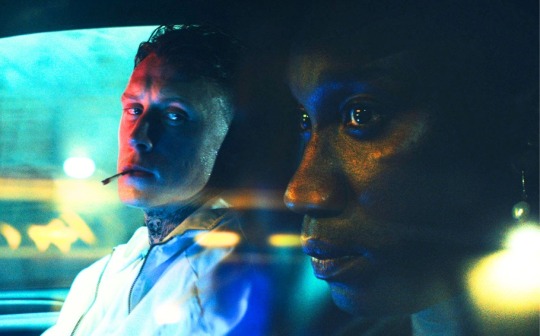
Queer Screen has unveiled the 31st Mardi Gras Film Festival’s full 2024 lineup of over 100 queer movies and shorts.
MGFF24 will come to cinemas across Sydney from February 15 to 29, with 161 films and events spread across unique programs.
National audiences can also stream films online on-demand from March 1 to 11.
The festival will open with the dark neo-noir thriller Femme, and close with Australian director Goran Stolevski’s chosen family drama Housekeeping for Beginners.
Festival director Lisa Rose said this year, the festival wants audiences to indulge in post-screening discussions and debate after watching the thought-provoking films.
“The theme focuses on films that start conversations. People will be keen to discuss and dissect them as soon as the credits start to roll,” she said.
“There’s so much to sink your teeth into, including several that will inspire lively debate.”
See all the films and book tickets at queerscreen.org.au and check out the highlights below.
Femme
The festival opens with the Sydney premiere of British neo-noir thriller Femme, a fierce psychodrama featuring phenomenal performances from Misfits star Nathan Stewart-Jarrett and George MacKay (Pride, 1917), about a drag star seeking revenge after a homophobic attack.
youtube
Housekeeping For Beginners
Australian filmmaker Goran Stolevski’s (Of An Age) delivers his signature fast-paced, witty dialogue in festival closer Housekeeping for Beginners. This sensitive, conversation-rich domestic drama finds joy in the chaos of found family.
youtube
Aristotle and Dante Discover the Secrets of the Universe
An evocative story of friendship and self-discovery between two teens in 1980s Texas, based on the critically acclaimed young adult novel.
youtube
All of Us Strangers
Paul Mescal and Andrew Scott reveal extraordinary intimacy in this beautiful, heart-wrenching film from director Andrew Haigh (Weekend).
youtube
Sunflower
Sunflower is an impressive first feature from director Gabriel Carrubba. Tender, atmospheric and touching, it follows Leo, a 17-year-old from working-class Melbourne who is questioning his sexuality.
youtube
A Portrait of Love
Documentary A Portrait of Love celebrates Archibald award-winning artist Craig Ruddy. Told through the eyes of his partner of twenty years, Roberto Meza, and directed by Molly Reynolds (My Name is Gulpilil), it’s an exuberant tale of creativity and devotion.
youtube
Sing-a-long: The Sound of Music
Calling all naughty nuns, cool captains and bratty kids! It’s time for The Sound of Music sing-a-long with the Order of Perpetual Indulgence.
youtube
Our Son
Boasting the power couple pairing of Billy Porter and Luke Evans, this is a sensitive, nuanced take on the breakdown of a long-term marriage.
youtube
Monica
Trace Lysette (Transparent) leads this lyrical tale of a trans woman called to care for the ailing mother (Patricia Clarkson) who disowned her.
youtube
Female Trouble
Glamour has never been more grotesque than in John Waters and Divine’s perverse classic Female Trouble, which celebrates its 50th anniversary.
youtube
Another Country
Celebrating its 40th anniversary, this gay classic features star-making (and swoon-worthy) performances from Rupert Everett and Colin Firth.
youtube
Happy Clothes: A Film About Patricia Field
What connects Sex and the City, The Devil Wears Prada and Emily in Paris? Fashion stylist extraordinaire and amazing lesbian Patricia Field.
youtube
Mutt
Non-binary heartthrob Lio Mehiel won a Special Jury prize at Sundance for their performance as trans man Feña in this raw, authentic drama.
youtube
Who’ll Stop the Rain
Evocative and romantic, this is the powerful story of two girls falling in love while protesting for creative freedom in post-martial law Taipei.
youtube
Along Came Love
In a sweeping love story spanning decades, a couple become one another’s saviours by hiding each other’s secrets in homophobic post-WWII France.
youtube
F.L.Y.
Two ex-boyfriends must live under one roof, putting their friendship (and some high heels) to the test, in this wistful comedy.
youtube
Girls Don’t Cry
Two teenage girls embark on a road trip through the Italian countryside. One is fleeing home, the other is desperate to return to her home in Romania.
youtube
I Am What I Am
A heartfelt anti-rom-com about an asexual woman grappling with the tension between her family’s expectations and her quest for independence.
youtube
The Mattachine Family
Nico Tortorella (Younger) and Emily Hampshire (Schitt’s Creek) star in this thought-provoking and funny look at chosen family.
youtube
Old Narcissus
This distinctly raw, erotically-charged drama delivers a powerfully melancholic portrait of ageing in Japan unlike anything seen before.
youtube
Tickets and passes for the 2024 Mardi Gras Film Festival are on sale now at queerscreen.org.au, with discounted tickets available to Queer Screen members.
For the latest LGBTIQA+ Sister Girl and Brother Boy news, entertainment, community stories in Australia, visit qnews.com.au. Check out our latest magazines or find us on Facebook, Twitter, Instagram and YouTube.
0 notes
Text
Amazing Tales from the Bush by Australian Animal Book Author, David Kentish
Best-selling Australian author David Kentish has written children's books that tell the many tales of the Australian bush animals. Inspired by the stories told by his father during his early years, David continued in the same vein and has now become one of the best-selling Australian authors from the bush.
As one of the best-selling Australian authors from the bush, David's range of works has proven that there is more to the harsh and distant bush and outbacks than meets the eye. Among his Australian children's books that are set in the bush include "Babington's Treasure Map", "Beside the Billabong", and "The Little Pink Dragon Who Couldn't."
Apart from children's books, David has also written "King's Gold," "Horseshoes and Fences," "The Kentish's of Keysbrook" which is a book on his family history, and "KVK: A Life Well Lived" which is a biography about his mother. David is also one of the many Australian authors with audiobooks and a collection of short stories, which can be read in "The Fantastical Collection of Enlightening Short Stories."
David is continuously creating great stories from his travels across this equally great country of ours, and readers will be assured that there will always be more to come!
1 note
·
View note
Text
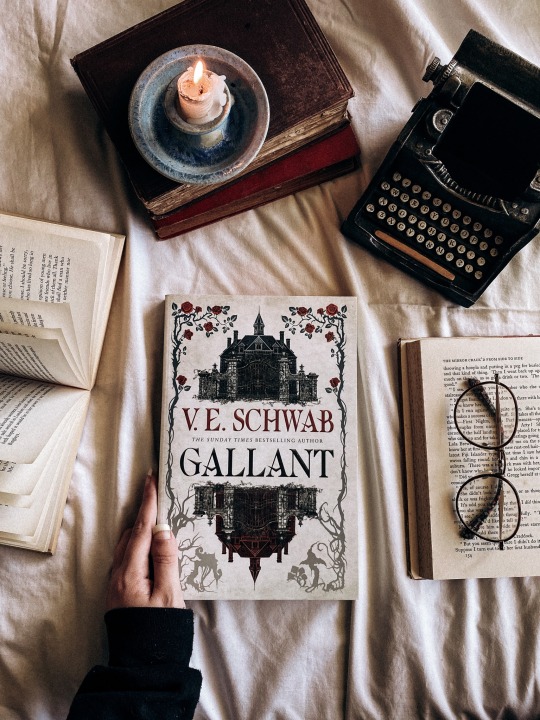
BOOK REVIEW: Gallant by V. E. Schwab
Olivia Prior has grown up in Merilance School for girls, and all she has of her past is her mother’s journal which seems to unravel into madness. Then, a letter invites Olivia to come home to Gallant. Yet when Olivia arrives, no one is expecting her. But Olivia is not about to leave the first place that feels like home, it doesn’t matter if her cousin Matthew is hostile or if she sees half-formed ghouls haunting the hallways.
Title: Gallant
Author: V. E. Schwab
Published by: Titan Publishing
Publication Date: 01/03/22
Australian RRP: $32.99
Genres: young adult, fantasy,
Pages: 310
Format: Paperback
Rating: 4/5
Synopsis:
Number one New York Times bestselling author Victoria Schwab spins a dark, original tale about our world full of life a world that mirrors it haunted by death and the manor that stands between them. The Secret Garden meets Crimson Peak in this novel perfect for readers of Holly Black and Neil Gaiman. Olivia Prior has grown up in Merilance School for girls, and all she has of her past is her mother’s journal which seems to unravel into madness. Then, a letter invites Olivia to come home to Gallant. Yet when Olivia arrives, no one is expecting her. But Olivia is not about to leave the first place that feels like home, it doesn’t matter if her cousin Matthew is hostile or if she sees half-formed ghouls haunting the hallways. Olivia knows that Gallant is hiding secrets, and she is determined to uncover them. When she crosses a ruined wall at just the right moment, Olivia finds herself in a place that is Gallant but not. The manor is crumbling, the ghouls are solid, and a mysterious figure rules over all. Now Olivia sees what has unravelled generations of her family, and where her father may have come from. Olivia has always wanted to belong somewhere, but will she take her place as a Prior, protecting our world against the Master of the House? Or will she take her place beside him?
Trigger Warnings: ableism, bullying, grief, death, death of a parent,
Review:
Gallant by V. E. Schwab is a young adult spooky tale about family, finding yourself, and home. From the first page, the eerie atmosphere of the story captured my attention. V. E Schwab's writing is engaging and weaves a beautifully spooky tale.
Gallant tells the story of sixteen-year-old Olivia Prior as she is summoned to an estate and finds the family she didn't know she had. Olivia has no voice and communicates through sign language, drawings and writing things down. I loved how the illustrations throughout Gallant helped to tell the story. Olivia is such an interesting character; she was determined to solve the mysteries of Gallant and what happened to her parents. The feelings of grief, loneliness and fear are explored so well in this book.
Overall, If you are looking for a dark, spooky and atmospheric tale, I highly recommend reading Gallant.
Thank you to Titan Publishing and New South Books for sending me a copy in exchange for an honest review.
#books#bookworm#book addict#booklr#bibliophile#thechronicbookworm reviews#book review#gallant#spoiler free review
287 notes
·
View notes
Text
A mutual friend introduced me to Michael [Jackson] and given that I'm a rabbi, and he's not Jewish, I didn't know if there would be a deep spiritual connection between us. Michael was a Jehovah's Witness, but I was amazed at how deep that spiritual bond was.
I think people forget that he was a missionary, knocking on peoples' doors on Sunday, handing out watchtower magazine, even after Thriller. He was raised a very devout Jehovah's Witness.
And though we connected, I also don't believe humans are meant to live as gods. The moment I felt like my advice could not be heeded - because I wasn't a fan, I was a friend - I felt that's when I had to leave, and I severed our relationship. I didn't know whether to believe the allegations. What I did know was that regardless of whether it was true or not, Michael could never really again be around children.
Michael said he wanted to leverage his celebrity to help the world's children. So what I said to him is, 'you were never meant to be the child's Messiah. Stop thinking that you're the one who's supposed to give all the world's neglected children attention.'
Gavin [Arvizo]'s family arrived one day, and I was actually almost convinced, that Michael had brought them to impress me, to show me his good works. Because Gavin was a child who was suffering from cancer. When the trial happened - he was very reclusive, very secluded - so it was hard for me to believe anything had happened, because Gavin was also there with his family.
But before this documentary, we've never heard allegations this explicit, we've never seen the faces of the accusers as they make these allegations, and we've never heard the family members who've had to shoulder that pain. To see the guilt that the parents are feeling, touched me very deeply. And hearing their spouses - when you marry someone who has experienced deep trauma and how you have to help carry that burden.
When I first saw the Bashir documentary I was outraged. You cannot share your bed with a child, that is immoral, unacceptable - it's deplorable. I remember watching it - and feeling like I had been kicked in the stomach. I could not believe that he had done that - and that he had said it.
If Cardinal [George] Pell was a uniquely Australian tragedy of a country traumatized by its more senior religious prelate accused of these monstrous crimes, Michael was almost a high priest - of superstardom. And then you can also do things you're not called out on. This is a profound morality tale for all of us. I don't believe these men are lying. And I don't believe the shame and guilt being experienced by their parents - their mothers in particular - are feigned.
I think the cognitive dissonance kicks in with all of us in our inability to confront the most painful truths. And like Cardinal Pell, I can understand that when you have someone who is the head of an entire church for an entire country, it's hard to reconcile. They still respect and revere religious figures. But that discomfort doesn't excuse our need - our responsibility - to speak out, and to accept that there's a right and a wrong in this world.
-Rabbi Schmuley Boteach
1 note
·
View note
Photo

☄ 𝗜𝗦𝗦𝗨𝗘 𝟭𝟬𝟳. → ❝ 𝐓𝐇𝐄 𝐎𝐑𝐀𝐂𝐋𝐄 ❞

☄ → magnetic island event; the big beach bash !
(UPCOMING RP EVENT!) — the second weekend of march neptune bay will turn into a family friendly beach fair; complete with games, booths, food and drink, water sports rides, entertainment, land games, a raffle and countless fun activities for everyone. for those over eighteen come on down on saturday night for a bonfire! there will be fireworks, cocktails, exotic performances and more. more details to be released !
☄ → magnetic island birthdays; march !
pisces — liam harrison / @pvseidvnn, 12th march, 1985
aries — lilac xiao / @lilacwalks, 29th march, 1997
☄ → showing @ pythia’s drive in!
bran nue dae (2009) — a rebellious boy runs away from a catholic boarding school and tries to hitchhike to his aboriginal home in australia. ☄ + our australian film of the month!
free guy (2021) — a bank teller who discovers he is actually a background player in an open-world video game decides to become the hero of his own story.
the hobbit: an unexpected journey (2012) — bilbo baggins, a hobbit, is persuaded into accompanying a wizard and a group of dwarves on a journey to reclaim the city of erebor and all its riches from the dragon smaug.
bad boys for life (2020) — detectives mike lowrey and marcus burnett join the miami’s police department’s special team, ammo, to bring down the ruthless armando, who is on a mission to kill mike at his mother isabel's orders.
ammonite (2020) — mary anning, an acclaimed fossil hunter, is forced to care for a rich visitor's sick wife, and the two develop an intense bond that forces the two women to re-examine their relationship. ☄ + our lgbti+ film of the month!
lilo and stitch! (2002) — a tale of a young girl's close encounter with the galaxy's most wanted extraterrestrial. lilo is a lonely hawaiian girl who adopts a ‘dog’, whom she names stitch. stitch would be the perfect pet if he weren't in reality a genetic experiment who has escaped from an alien planet high security prison and crash-landed on earth, with others in hot pursuit to capture him. ☄ + our anniversary film of the month! (20th anniversary)
☄ → reopened !
pythia’s drive in — newly refurbished with an a new third screen, magnetic island’s only theatre is open once more. complete with a new snack bar, including a a full section dedicated to planet-based treats, what a better place for a night out? check the listings for what movies are showing, we can’t wait to see you there!
books & crannies — the beloved eclectic bookstore has joined partnership with the cafe next door, and now we have a place to get a delicious cup of coffee and a snack whilst reclining and reading one of the thousands of copies tucked away in all the nooks and crannies of the building.
4 notes
·
View notes
Text
E2 artworks are for the most part delightful, but today, I would like us to pay particular attention to certain characters’ Elite 2 artwork: Nightingale, Cuora, and Specter.
The three of them have two things in common: The first is that they are all amnesiac (or, in the case of Nightingale, partially amnesiac, but amnesiac nonetheless), the second is that they are all drawn by Skade. I think the Hypergryph writers just have an Amnesiac Hotline for whenever they conceive another amnesiac character and it connects directly to Skade’s temporal lobe, where all information about the new character is immediately uploaded to and then he just starts furiously drawing.
But let’s focus on the fact that they are amnesiac in this post, and how this is reflected in their E2 art in a way I found clever. Let’s begin with our favorite fashionable demon, Nightingale.

Nightingale’s name is a two-fold allusion: The most evident one is being an homage to Florence Nightingale, the mother of modern nursing. The other, perhaps least apparent but of equal importance, is to the Greek aesop “The Laborer & The Nightingale”, which tells the tale of a poor laborer who, enthralled with the beautiful song of a nightingale that sang every day atop a tall cedar tree, grew selfish and built a cage of iron and twigs to capture the nightingale to make its songs his and only his. Her lines make several allusions to cages and empty rooms,


and of only being let out of her ‘cage’ when someone needed her healing powers, her “song”, if you will (especially relevant when you consider how song and Arts seem to be related in Terra). Her E2 art, thus, represents her bursting out of her cage or iron and twigs. Unlike other Sarkaz Operators, her E2 is not a shape or a representation of a Demon, it is, instead, a representation of her inner Demon, the cage of her head, which contains all of her memories and emotions locked tight within in. She’s not there yet, but she’s making progress. It is worthy of note that Shining also doesn’t depict a Demon in her E2 art, her artwork instead centering on her shield, but while Shining’s E2 art is an allusion of her deep, deep shame of being a Sarkaz and the things she’s done as a Sarkaz (or, in other words, denouncing her own identity to focus on what she truly wants to do from here on, which is to protect others), Nightingale’s E2 artwork instead depicts her destroying part of the cage that holds her back: She’s not fully out yet, but now, it is only a matter of time.
Then, what about Cuora?
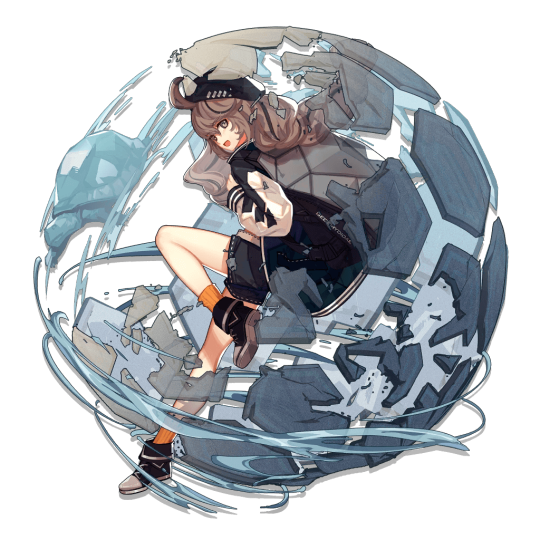
Some Operators show a manifestation of their identifying animal that might not be entirely physical but it’s clear, with hard colors and textures. Other Operators show their animal very clearly, as if it was truly there, like Perfumer and Siege, and in some cases, it REALLY is there, as with Eyjafjalla (who directly addresses them in a voice line), and this seems to be matter of artistic preference, but whereas Skade normally draws E2 manifestations with solid colors, in the case of Cuora and Specter, he chooses to make them almost phantasmal, with soft colors and an ephemeral feel to them instead. In fact, the turtle you can see above is as generic as can be, it doesn’t seem to be identifying of any particular turtle species, and all we know about it is that it is “a turtle”. This is deliberate, meant to represent Cuora’s amnesia: Her race, Petram, is not unknown, but she doesn’t remember what specific kind of Petram she is. There’s a lot of turtle species, so which one is she? We have no idea. We know Blue Poison is a Poison Dart Frog, we know Nearl is a Pegasus, so when it comes to species either real or fantastic, we usually have an accurate account of which each Operator is supposed to represent, but not with Cuora, because she’s amnesiac. Whatever specific kind of Petram she is, we’ll never know unless someone that can properly identify her or that knew her from before the amnesia can divulge that information. To represent this, thus, her animal manifestation is ephemeral, phantasmal, ambiguous: It shows us exactly as much as we know of it, that is, that she’s a turtle, nothing less, nothing more.
So where does this leave Specter?
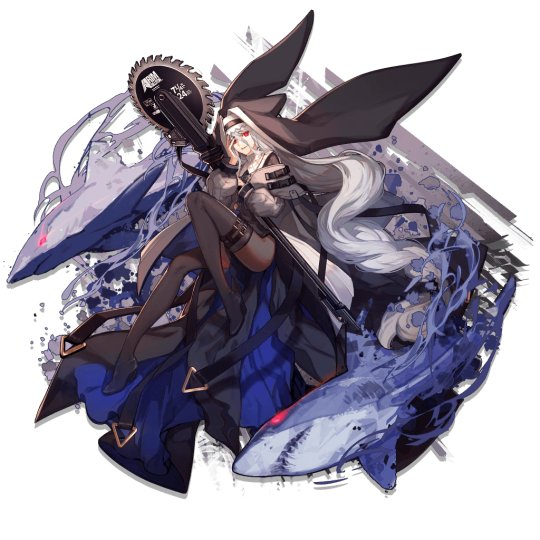
Nightingale has partial amnesia, Cuora is amnesiac but her Oripathy was caught in time and she’s been stabilized, but Specter’s nervous system has been ravaged, and not only is she amnesiac, she’s also prone to bouts of insanity and of sometimes saying some rather concerning things, such as wanting to take Doctor to the “place where secrets are imparted” or how “some people were never ever meant to be one, so it is her duty to cut them into many”.
Nightingale’s art, if you look above, is ‘solid’, bereft of particles or separated parts: It’s an iron cage, the twigs, and herself. Cuora’s art is somewhat more ‘loose’, with some weaving loose lines on the lower part of the drawing to presumably represent low tide, where you would normally find small turtles, as well as to represent her somewhat deteriorated but overall well-preserved psyche. Specter’s art, in contrast, is very loose: There’s an emphasis on aquatic trails all over the composition, representing the deep sea, as well as her flowing cloak, hair, and habit flaps. There’s many loose ‘particles’, like smudges of splattered ink, representative of her shattered psyche, and, most importantly, there’s not one but two sharks of different species as her animal representation. I believe they are representative of how she’s currently ‘two’ people: The somewhat manic but otherwise harmless Specter that can be found roaming the halls of Rhodes Islands’ dorms, and the completely silent fighting machine named Specter that can be found roaming the battlefield like a vengeful ghoul, following orders to the letter, her own safety be damned.
But there’s another meaning, I believe: Cuora at least has one turtle in her art, which can at least let us approximate which species it could possibly be (likely a freshwater turtle judging from comparative size and shell shape, bigger than tortoises, smaller than sea turtles), but Specter has two sharks, which means properly approximating her exact species becomes a lot harder. Skadi and Deepcolor, fellow AEgirians, make it very clear which animals they are supposed to be (Orca and Dumbo Squid, respectively), which further proves that this is a Specter-specific conundrum and not a Deep Sea trait. Likewise, her outfit has several allusions to the overall shape of a shark, but not to any specific shark.
If we want to dig deeper, and boy howdy I bet we do, we can take a look at the Chinese Hanzi that composes her name:
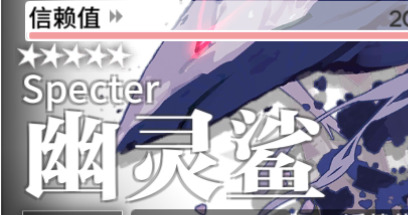


“幽灵鲨”, or “Yōulíng shā”, which translates literally to “Ghost Shark” from Chinese to English. Fitting that her codename is given as Specter. So, what’s a “Ghost Shark”, exactly? Aside, from, you know,
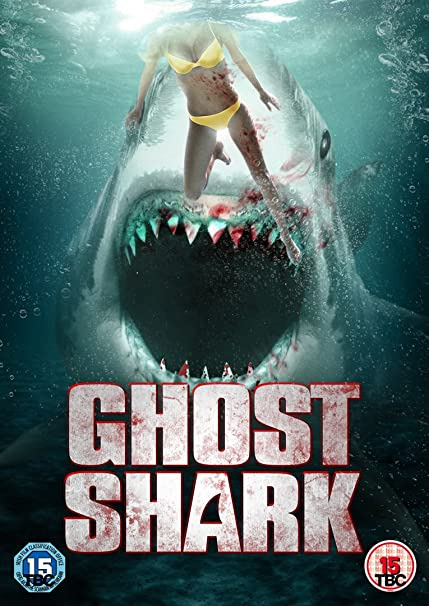
a really bad B-Movie.
Sounds like it’s just a cool poetic name for someone who is but a specter: a fleeting existence, with no memories, only a shadow of her former self, no?
Well, that works out, to be frank, but it turns out, Ghost Sharks are a real species. This is the Bahamas Ghost Shark:
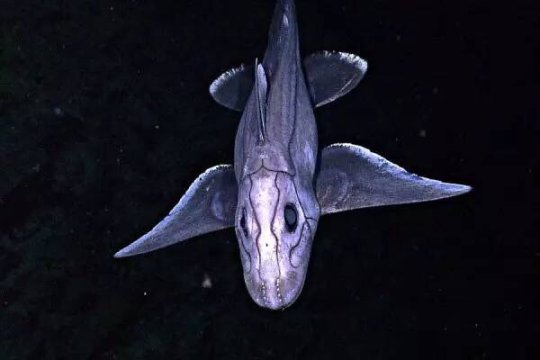
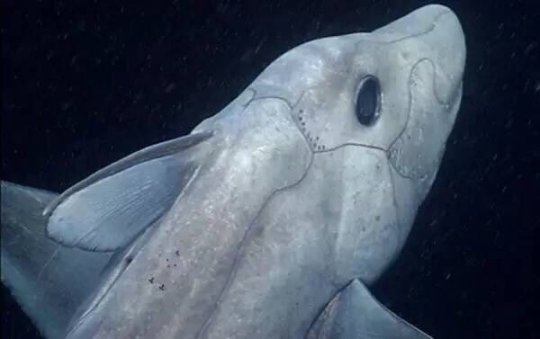
And this is the Australian Ghost Shark:
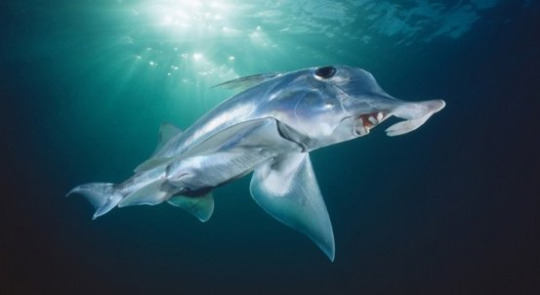
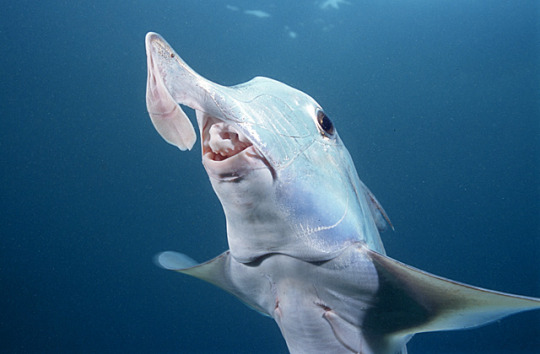
They belong to a species of fish known as Chimaeras, and they live in temperate ocean floors down to 2,600 m (8,500 ft) deep and are some of the oldest fish alive, they share plenty of characteristics with their prehistoric ancestors (or, to translate this to Arknights terms: keep in mind how Specter looks just like a regular human). These are deep sea fish, with only a couple of them coming close to the surface rarely, and it fits with what we know of Specter, what with her background of fighting giant Deep Sea monsters as an Abyssal Hunter. Of course, whether she is supposed to be a Chimaera of any sort remains to be seen, but it wouldn’t surprise me if she was, given the thematic similarities.
I found all of these little nudges and nods to be plenty fascinating. Am I perhaps reading too deep into this? Always within the realm of possibility! Are Skade and Hypergryph planting seeds of lore that will bloom much later, making every piece of evidence given until that point suddenly make cohesive sense? Wouldn’t put it past them! So analyze, analyze, and analyze, because even if it takes you nowhere, lord knows it’s fun to do so.
362 notes
·
View notes
Text
Both my grandparents lived until they were 80: Alfred died, still in Sydney, in 1963 and nan a year later — the same year my brother first went to Sydney on a tour with the Stones.
Chris Jagger, Tales of our Australian mother.
#chris jagger#mick jagger#the rolling stones#classic rock#old rockstar#sixties#rock n roll#rocknroll#rock#60s men#60s rock#60s#60s music#60s fashion#sydney#Australia#Tales of our Australian mother
4 notes
·
View notes
Photo
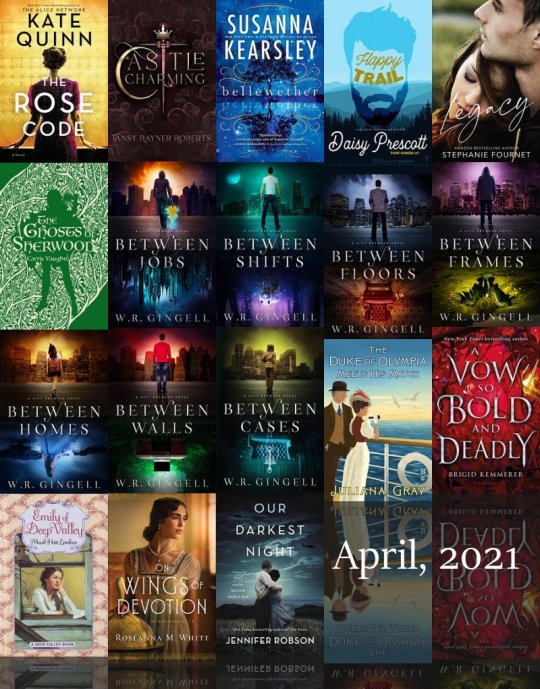
This was more-books-than-sometimes month, because rather than take the time to write about the books I'd finished, I just read more books! Also, I read a lot over the Easter break, including some shorter books and a very binge-able series.
Also read: Two-Step and Someone Like Me by Stephanie Fournet, Hooked by Cathy Yardley, “Cloudy with a Chance of Dropbears” and “All the Different Shades of Blue” by W.R. Gingell, and “Home: Habitat, Range, Niche, Territory” by Martha Wells.
Reread: A Curse So Dark and Lonely by Brigid Kemmerer.
Total: nineteen novels (including two audiobooks and one reread), one novella collection, two novellas, two novelettes and one short story.
Cover thoughts: Bellewether’s blue cover is (unsurprisingly) my favourite. I also really like The Ghosts of Sherwood.
Still reading: A Portrait of Loyalty by Roseanna M. White and Playing Hearts by W.R. Gingell.
Next up: Torch by R.J. Anderson.
My full reviews are on Dreamwidth and LibraryThing.
*
The Rose Code by Kate Quinn (narrated by Saskia Maarleveld): Historical mystery about three young women who worked at Bletchley Park during WWII.
My favourite out of the books I’ve read so far this year. Most of the narrative is set during the war, but interspersed with sections set in 1947 -- when Beth, in a sanitarium after a breakdown, has sent her two estranged friends a coded message begging for help. I loved this, but at times found it stressful and heartbreaking! The writing is so lively and effective and emotional. 4½ ★
*
Castle Charming by Tansy Raynor Roberts: Fairytale retellings, collection of novellas.
A very entertaining and a somewhat different take on fairytales, focusing on the reporters, Royal Hounds and royalty at Castle Charming. Some of the character dynamics felt similar to those in Roberts’ Unreal Alchemy although I didn’t feel quite as attached to these characters. I’ll read the sequel. 3 ★
*
Bellewether by Susanna Kearsley: Historical and contemporary fiction, set in Long Island during the so-called Seven Years War in 1759 and the present day.
Alternates between a curator overseeing turning a house in a museum and some of the house’s previous occupants, including a French-Canadian Lieutenant awaiting hostage exchange. Despite the various tensions the characters face, there’s something slow and ultimately gentle about this story. Which is lovely -- I enjoyed the picturesque sense of place and astute observations of people -- but it is less dramatic than I was expecting. 3½ ★
*
Happy Trail by Daisy Prescott: Contemporary romance, set on the Appalachian Trail.
A park ranger and a hiker shelter together during a storm. I was fascinated by the insight into hiking the Appalachian Trail and enjoyed some of the characters’ interactions, although I thought the way the romance unfolded was somewhat anticlimactic. Not always what I wanted, but I don't regret reading it.
*
Legacy by Stephanie Fournet: Contemporary enemies-to-roommates-to-lovers.
Wes offers to move in with his late-best friend’s girlfriend to help her out financially. This sort of hurt/comfort appeals to me. I liked how seriously this story takes Corinne’s messy, consuming grief. I don’t really want to spend any more time with the characters, but I was very invested in seeing them reach a better place in their lives.
Two-Step by Stephanie Fournet: Contemporary romance between an actress and a dance instructor. I enjoyed reading this. I particularly enjoyed how Beau helps Iris with her anxiety about dancing and with her controlling mother/manager. He’s very supportive and understanding! But I finished this with a niggling feeling of dissatisfaction -- Iris needed more opportunity to support Beau in turn.
Someone Like Me by Stephanie Fournet: Contemporary romance between a yoga instructor and her new neighbour, who has just got out of prison.
This one didn’t particularly appeal to me. Although interesting to see the experiences of someone recently released from prison, the romance developed too quickly.
(No, I didn’t read all three of these back-to-back!)
*
Hooked by Cathy Yardley: Contemporary fandom-y romance novella, set near Seattle. Takes place during Level Up and is about two of Tessa’s colleagues.
I enjoyed the characters' interactions and would have liked this more if it hadn't felt rushed.
*
The Ghosts of Sherwood by Carrie Vaughn: Historical Robin Hood retelling, novella.
Exactly what I wanted! It alternates between Robin and Marian’s eldest daughter, Mary, and Marian herself. I liked seeing Robin and Marian as a long-married couple, who still love each other and still have disagreements. And the dynamic between their children gave me a zing of recognition, reminding me of my siblings. 3½ ★
*
The City Between by W.R. Gingell: Australian YA urban fantasy (murder) mysteries. Set in Hobart.
I ended up enjoying this series so much more than I’d expected to!
Between Jobs: After a neighbour is murdered, our seventeen-year-old orphaned narrator acquires some unexpected housemates -- two fae, one vampire. Once I got past the opening, with its tales of murder, the worldbuilding intrigued me. I still wasn’t sure what I thought about her housemates or the fact that they call her “Pet”, but was willing to reserve judgement until I’d read more. 3 ★
Between Shifts: About supermarket shifts and shapeshifters. Pet and JinYeong go undercover at the local grocery store. This is a reasonable murder mystery. I was initially disappointed with how something played out (but in retrospect can see how that was actually a positive development for Pet). It ended on a cliffhanger, so I was extra motivated to start the next book. 2½ ★
Between Floors: This is where the series took off, because things suddenly get personal! One of her fae housemates has been captured and the closest any of them get to finding Athelas is Pet contacting him in her dreams.This raises a lot of interesting questions, not just about Pet’s abilities, but about her relationship with her housemates. How much does she trust them and how much do they value Pet’s personhood? 3½ ★
Between Frames: Pet’s housemates are hired to investigate a series of fae deaths around Hobart, which involves scrutinising some baffling security footage. Another solid murder mystery. The final pages felt like one step forward, two steps back, but yet again, in retrospect, this was a positive development. I’m glad I could dive immediately into the next book. 3 ★
Between Homes: Pet has moved in with some friends. Hurray for Pet having friends! I think this was the point where I started to feel comfortable with Pet calling herself Pet -- when it's the name used by people she likes and trusts and who don’t view her as a pet at all. 3½ ★
“Cloudy with a Chance of Dropbears” (novelette): An awesome title and an entertaining opportunity to see Pet from someone else’s perspective -- moreover, someone who doesn’t know her or what she’s capable of. 3 ★
Between Walls: Pet’s friend Morgana is worried about an online friends and asks Pet and co to investigate his disappearance. Along the way, they discover that there are human groups who actually know a lot about Behindkind. I am also becoming increasingly entertained by the Korean vampire. 3 ★
“All the Different Shades of Blue” (novelette): A great cover and it explains who that guy at the cafe is, but otherwise didn’t really do anything Cloudy with a Chance of Dropbears hadn’t already done -- ie., show us Pet from someone else’s perspective. Most of the time, I have enjoyed this series all the more for binging it, but I suspect this particular story would have worked better if I had read it after a period of absence. 2½ ★
Between Cases: My favourite of these have been the ones where things get personal, and this involves a lot of revelations about who Pet is -- from a fae perspective -- and why her parents were murdered. I enjoyed this one a lot. 3½ ★
*
The Duke of Olympia Meets His Match by Juliana Gray: Historical espionage romance novella, set in 1893 onboard an ocean liner travelling to England. Apparently not the Duke’s first appearance in Gray’s fiction.
I liked the idea here much better than the execution. I liked Penelope, a fifty-year-old widow dependent upon her position as a governess, and I enjoyed her interactions with the older Duke of Olympia. But parts of the spy plot were rushed or confusing, and the resolution was almost-but-not-entirely satisfying. 2½ ★
*
A Vow So Bold and Deadly by Brigid Kemmerer: Fantasy. Follows on from the fairytale-retelling A Curse So Dark and Lonely and its sequel, A Heart So Fierce and Broken.
If this is meant as a conclusion to a trilogy, then the ending was a bit too anticlimactic, with a few too many loose ends, to be really satisfying. But I reached the end feeling positive about the story, because I really enjoyed the characters’ interactions. All of the protagonists have to deal with conflict in relationships. I loved the times when they each navigate these conflicts by acting fairly and communicating honestly, when doing so is often difficult and complicated. That’s realistic and satisfying. 3½ ★
*
“Home: Habitat, Range, Niche, Territory” by Martha Wells: Science-fiction short story. Part of The Murderbot Diaries series, set after Exit Strategy.
Very, very short but I really liked seeing things from Dr Ayda Mensah’s (third person) perspective. 3½ ★
*
Emily of Deep Valley by Maud Hart Lovelace: Historical coming-of-age fiction, set in Minnesota in 1912-3.
I am very glad to finally have read this! It’s delightful, a fascinating insight into community life in a Minnesotan town, and it effectively captures the emotional experience of navigating a period of transition. After high school, Emily’s friends leave for college, but Emily has to find her own path to purposefully fill her time, build connections and further her education. 4 ★
*
On Wings of Devotion by Roseanna M. White (narrated by Susan Lyons): Romantic historical mystery, set in London during 1918. Christian fiction. Features characters from The Number of Love.
Arabelle Denler is a nurse working in a London hospital; Phillip Camden is an airman now working for British Intelligence. I enjoyed their interactions, especially once they start to get to know each other. I didn’t like the antagonist’s contribution to this narrative -- between the dangers of wartime and the protagonists’ respective issues, there’s enough tension without her. But what I enjoyed about this story outweighed what I didn’t. 3½ ★
*
Our Darkest Night by Jennifer Robson: Historical fiction set during the Nazi occupation of Italy in WWII.
Nina, a young Jewish woman from Venice, goes into hiding by pretending she’s married to Nico, a Catholic farmer. Robson’s strength lies in pairing details of daily life with likeable characters, realistic dialogue and a sweet romance. I read this quickly and eagerly. But if the characters had been more nuanced, more complex, or if their emotions had been conveyed more vividly, I likely would have found reading this a more emotional experience. 3½ ★
21 notes
·
View notes
Photo
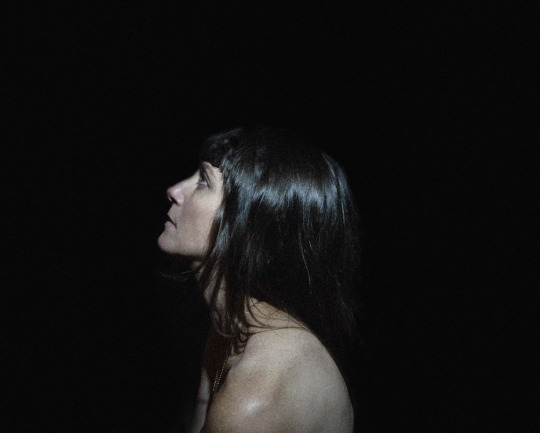
INTERVIEW: Penelope Trappes.
Australian-born Brighton-based musician Penelope Trappes has shared a new single and accompanying short film directed by Agnes Haus, ‘Blood Moon,’ from her forthcoming album Penelope Three. The album will be released next Friday, May 28 on Houndstooth. Following singles ‘Fur & Feather’ and ‘Nervous,’ ‘Blood Moon’ is atmospheric and dreamlike; a song about repurposing the fear within.
"I consider the moon a temple, a mirror of our emotions,” elaborates Trappes. “The blood moon symbolically represents the beginning, the ending and a clean slate. ‘Blood Moon’ is about being uncompromisingly true to oneself despite societal expectations. Everyone should be free to express femininity in their own individual way. The burdens and expectations instilled in us at childhood weigh us down and hold us back. This song is about never giving in to this pressure and dismantling a system of oppression that is carried within our bodies. A metamorphosis." Commenting on the accompanying visual, she adds: "The short film ’Blood Moon’ is a modern take on the goddess Isis if she were around to face today’s world. Isis is the protector of women and children and the healer of the sick - but despite her powers, she would still be weighed down by societal expectations of what is expected of women."
We sat down with Penelope to discuss Penelope 3, being back on stage and what she has planned next. Read the full interview below.
Hi Penelope! How are you? How have you been coping with everything thats been happening this past year?
"Hello! I’m doing well, thanks. Keeping sane in a world gone a bit mad. I’m doing daily yoga and meditation, I’m vegan and very recently gluten-free, which has been great! I’m a bit of a bore with the health stuff...but I love taking care of my body. Also, after sometime of getting used to it, I am now embracing the slower pace of life, what with no travel, and less commuting places. It’s a bit like how I imagine things were in say Victorian times... but with internet."
You're gearing up to release your new album Penelope Three. In it you explore your metamorphosis through tales of motherhood, the divine feminine, anxiety, healing powers and their spiritual connections. What sparked the inspiration to write about these themes?
"I have always felt emotions deeply within my body, since I was a child, particularly ancestral trauma. I am not sure if there is a word for this, but it’s my reality and at times it has been quite hard to cope with. So as I have been going through a lot of physical changes in my own body in recent years, these have shifted and moved me on a much deeper level - emotionally and spiritually. On top of that there was the pending separation anxiety of my sole daughter leaving home, which turned out to be more emotional than I expected. Living overseas for all of my adult life has always been difficult in relation to my family back home in Australia. My mother is getting older and more unwell, and with my not being able to visit her in Australia due to the pandemic, i had to dive deep to find coping mechanisms. All the imposed alone time and the isolation has led to a lot of introspection. I am thankful to be able to find healing in channeling these feelings through the power of writing."
Sonically, how is Penelope Three different (or similar) to your previous releases? Were there any musical influences or sounds that you were able to incorporate on this record that you hadn’t previously?
"For Penelope Three, I based most of the compositions around my voice and words telling more of a tale. In the past i chose to pause on that aspect of myself and let the space take the forefront. I also explored a few more elements of my voice that I had trained in when I first started doing music, including jazz, opera, and sacred music. It’s not to say this album doesn’t have space like the last two albums, it does, but perhaps the pieces might feel a little more like “songs” on this one."
What was the creative process like this time around? Did lockdown affect it at all?
"The album was actually finished before lockdown. I wish I could say I was creating music since the pandemic, but sadly no. I was spending a lot of time during lockdown just trying to navigate life itself, though i did find the time to co-direct, film, and work on the visual side of Penelope Three. ‘Penelope Three’ actually falls into a strange world of before, during, and after. It has grown with the changing world. I think it sits well in all realms of past, present and future - which the visuals that accompany the album represent."
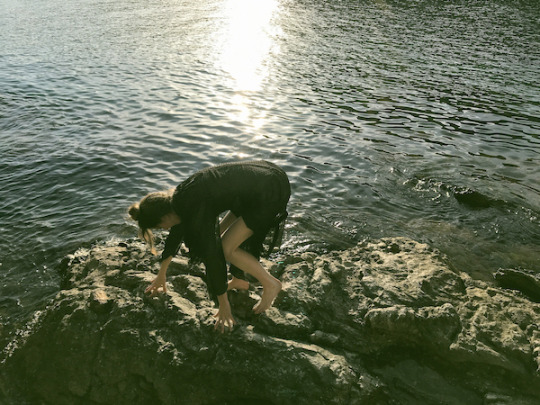
What was your favourite part creating Penelope Three? And were there any parts you found particularly challenging?
"There were times during the initial creative process that I went way out there, right off on tangents. Sometimes quite dark. I really enjoyed exploring this side of me but sometimes it was a little bit too much. It was challenging to decide to put some of this off to the side and stay present in hope. I would say my favourite part of creating P3 was in making the final decision to embrace the many voices I carry within me, curating these into one cohesive album."
What do you hope fans will take away from the new album?
"Hopefully they have heard Penelope 1 and 2 and can feel the vision and the love now that I am at the end of the trilogy. Either way, a sense of strength versus vulnerability and the empowerment that comes from embracing both of these qualities is what I hope they find while listening."
You have some live dates lined up in September. I expect you’re excited to be back on stage. What have you missed the most about performing?
"I have missed sharing the music and the space with an audience. Those moments when you can hear a pin drop. Sharing these fragile moments together where anything could happen will be pure joy!"
Will there be any changes to your live show?
"I now have a cellist and keyboardist / backing vocalist on stage with me, two wonderful women, Maddie Cutter and Hinako Omori. The 3 of us sharing the stage together helps to communicate the elements of fragility and strength within P3. It also frees me up to play guitar and really focus in on the vocals a bit more because in the past, I was multi-tasking on stage and had to rely on a holding down a lot of synths keys and chords the whole time."
Based on your musical journey so far, what’s been your biggest takeaway/piece of advice?
"Don’t ever stop creating no matter what family, friends or society tell you! Just keep evolving, changing and exploring everything that inspires you."
Finally, what else is next for you? Any non-musical goals?
"With Penelope Three, I have been working a lot on videos and I’m intending on exploring more aspects of filmmaking. I am particularly inspired by acting and the concept of story-telling and expressing all the emotions of life just through a delicate glance, the flick of the hand, or a tear. I am interested in telling tales with the body - with performance - but without music. I want to embrace the confrontational. I am also thinking a lot about musically what comes after this Trilogy. I have half of the music written already for a future album, but I just need to define what it’s all about before i continue on it."
youtube
Penelope 3 is out May 28 via Houndstooth.
Photo credit: Agnes Haus
11 notes
·
View notes
Photo

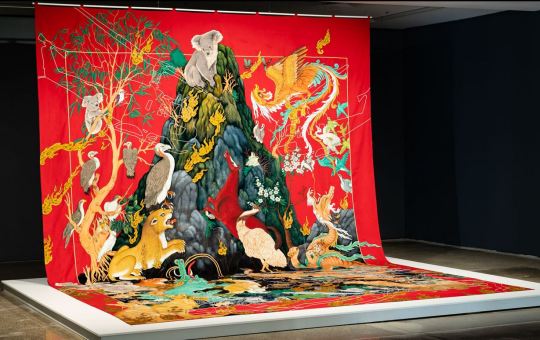
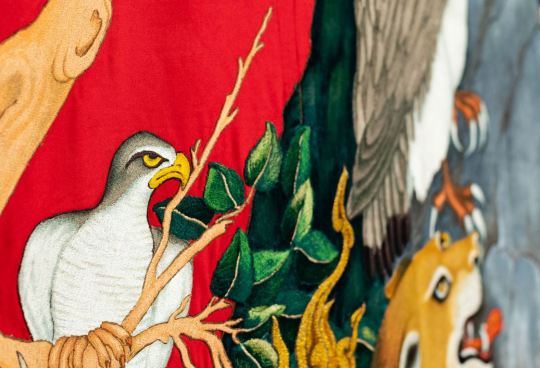
Kadim Ali b. 1978, Pakistan; lives and works in Sydney Australia
Sermon on the Mount (2020)
Linen, cotton, nylon, ink, natural dye, synthetic dye, acrylic paint; painting, hand and machine embroidery, appliqué 557 x 397.5cm
Born 1978 Quetta, Pakistan, Khadim Ali currently lives and works in Sydney, Australia. After growing up in Pakistan as a refugee, Ali was trained in classical miniature painting at the National College of Arts in Lahore and in mural painting and calligraphy in Tehran.
1 ima.org.au “I became other. I became one of the wearied, dusty faces from across the border. And although there was no boundary between us, and we were all citizens of one country, suddenly an invisible border of horror was drawn around me that made it impossible to get out” Khadim Ali
In his largest Australian solo exhibition to date, Hazara artist Khadim Ali explores the normalisation of war and the experience of refugees through a series of poetic installations and textile works. Invisible Border comprises sound installation, miniature painting, and a monumental 9-metre-long tapestry, hand woven by a community of Hazara men and women, some who have lost family members in war. Featuring existing work alongside new commissions developed for the IMA, the exhibition will also feature Otherness, a major body of work developed in partnership with the IMA and Lahore Biennale Foundation.
Ali’s interest in tapestries developed soon after his parents’ home in Quetta, Pakistan was destroyed by suicide bombers. Amongst the rubble and debris left from the blast, a collection of rugs and weavings remained the only thing intact: miraculously able to withstand the reign of terror inflicted upon his family and community. In this new large-scale tapestry, and other works, Ali explores the impact of war, trauma and displacement drawing parallels from the Book of Shahnameh, a Persian literary masterpiece comprising of 50,000 couplets and written between c. 977 and 1010 CE.
Just like the many great mythic tales in the Shannameh, Ali’s intricate works depict stories of demons and angels, conquest and war through the lens of the persecuted Hazara community. Expressing the profound grief, trauma and loss experienced at the hands of modern-day warfare, Invisible Border is a necessary and vital exhibition during a time of political propaganda, violence, and fear.
2 ima.org.au Ali’s interest in tapestries developed soon after his parents’ home in Quetta was destroyed by a car bomb. Amongst the rubble and debris left from the blast, a collection of rugs and weavings remained the only items intact: miraculously able to withstand the reign of terror inflicted upon his family and community. In these new large-scale tapestries, Ali makes comment on war, geo-politics and personal trauma, drawing from a range of historical and contemporary influences including the recent Black Summer bushfires, Persian literary masterpieces, children’s fables and the Mughal Dynasty. Expressing the profound horror, grief and loss experienced under modern-day warfare, Invisible Border is a necessary and vital exhibition during a time where political propaganda, violence, and fear pervades global relations.
3 Daisy Siddal inqld.com.au Ali has lived in Australia since 2009, nominated to arrive on a distinguished talent visa by then QAGOMA Director Tony Ellwood. Ali has worked between Australia and Afghanistan ever since.
Ali’s most recent work, Sermon on the Mount, adopts inspiration from the Bible and the Black Summer bushfires to generate a criticism of the experience of climate change.
Ali, who lives in Sydney’s inner-west, said his home was 40km away from the Black Summer bushfires.
“During the black summer we had horrible smoke. We were barely able to breathe. I was looking at the smoke and it was nostalgic, reminding me of the war,” he said.
“It reminded me of the stories people told when fleeing from a town that was set on fire, saying there was smoke on the mountain.
“The people who set their villages on fire, the Taliban and Al-Qaeda, they were considered a terrorist organisation. What do you call the corporations who caused climate change and set fire to a significant part of the forest of Australia?” he said.
IMA [Institute of Modern Art, Brisbane] Executive Director and exhibition curator Liz Nowell said she was thrilled to present Ali’s largest exhibition to date, in his adopted home of Australia.
“Khadim Ali is without a doubt one of Australia’s most acclaimed artists. His thought- provoking and poetic works have been seen all over the world: from the Guggenheim in New York to the Venice Biennale,” Ms Nowell said.
“Through intricately constructed textiles that draw on literature, traditional art forms, personal narratives and global politics, Invisible Border speaks powerfully to the experience of displaced peoples everywhere.”
4 guggenheim.org Born in 1978, Khadim Ali grew up in the border city of Quetta, Pakistan, near the border with Afghanistan. Trained in the art of contemporary miniature painting at the prestigious National College of Art in Lahore, Pakistan, and in mural painting and calligraphy at Tehran University, Iran, Ali is inspired by his rich cultural heritage and employs traditional artistic techniques to convey the complex history of this region. His work provocatively confronts the social and religious prejudice his family has faced and considers its effect on the writing of history, particularly during wartime.
5 ima.org.au Since relocating to Sydney twelve years ago, Ali has begun incorporating quotidian Australian iconography such as eucalyptus, currency and kangaroos into his work. Sermon on the Mount (2020) is an example of the artist’s evolving visual language. A direct response to the 2020 Black Summer bushfires—which devasted much of Australia’s bushland—the work depicts a cast of animals and mythical creatures seeking refuge atop a mountain engulfed in flames. The title of the work, Sermon on the Mount, makes direct reference to a series of teachings attributed to Jesus Christ, and widely considered to contain some of his most important messages. This composite tapestry, which was initially constructed as a digital collage, is the artist’s reimagining of a 15th century illustration from the Anwar-i Suhayli. Widely considered a masterpiece of world literature, the Anwar-i Suhayli (also known as Kalīla wa-Dimna, in Arabic, or Panchatantra in Sanskrit) is a collection of fables describing animals as heroic creatures. In the original drawing, held in collection of the British Museum, a crow addresses a group of birds to rally their support against a leader of the owls. In Ali’s version, the crow is replaced by a koala, who is seen towering above a cluster of animals as she delivers a prophecy that foretells the destruction of mother nature at the hands of humankind. While watching the fires unfold on the evening news, Ali was overcome with a deep and pervasive fear, which he likens to his experience living in a conflict zone.
As the artist himself states ‘The bushfires reminded me of the violence I spent my life trying to escape. At the same time as the Taliban burns people and their homes to the ground, a fire—only 40km from my house in Sydney—decimated whole species and blackened thousands of hectares of bushland. As the newsreader described animals feeling for their lives, I recalled whole villages hysterical and panicked as they tried to escape fire. So, what then, should we call these people—these corporations—who are destroying our natural world and quite literally scorching the ground we walk on?’
10 notes
·
View notes
Photo
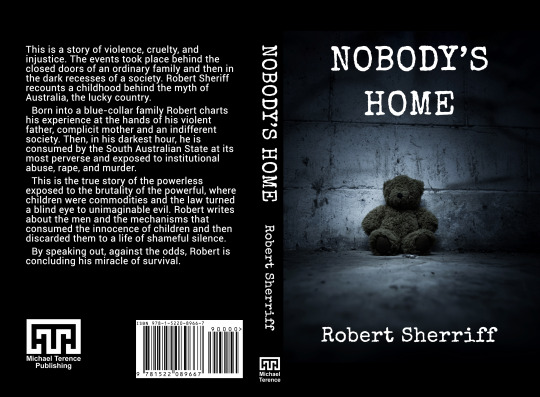
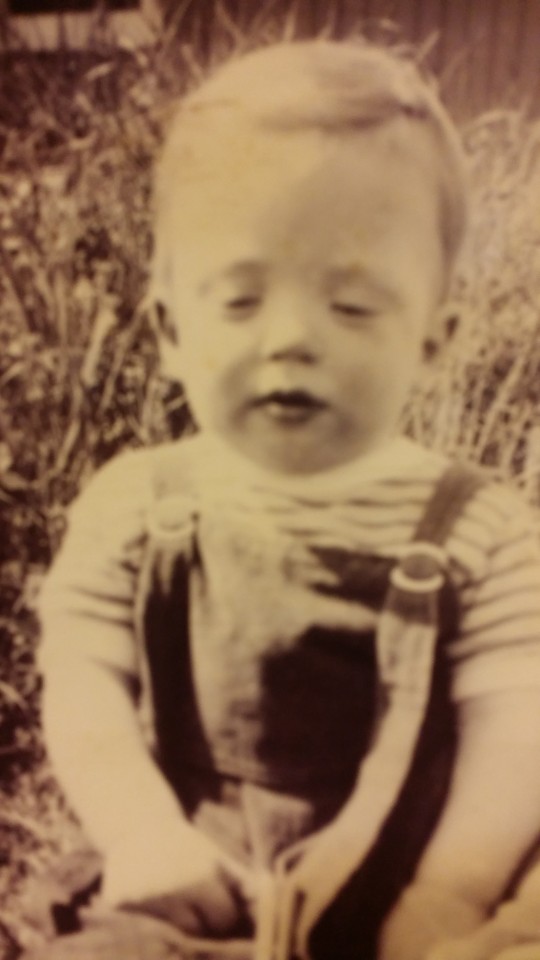
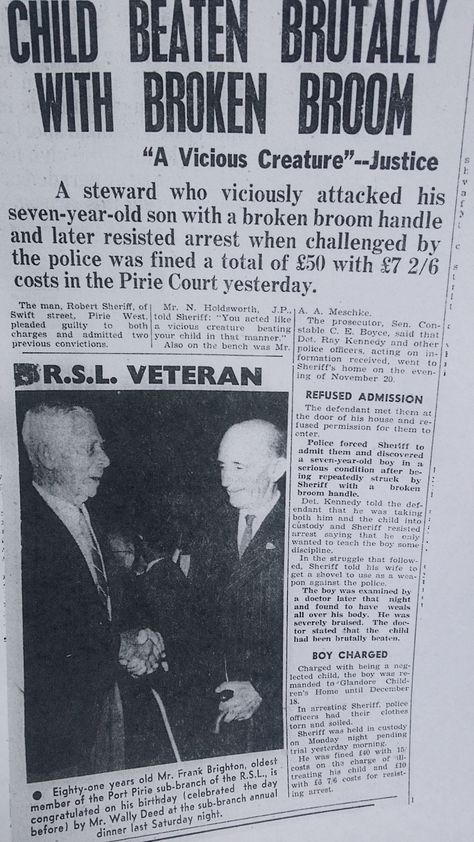
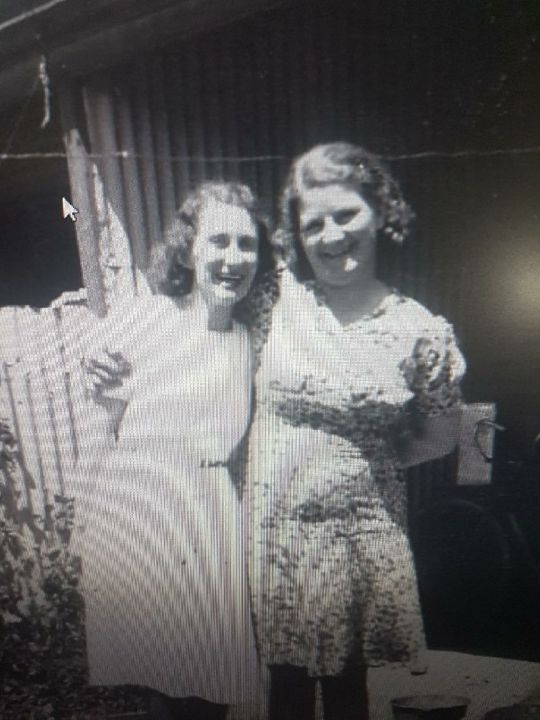
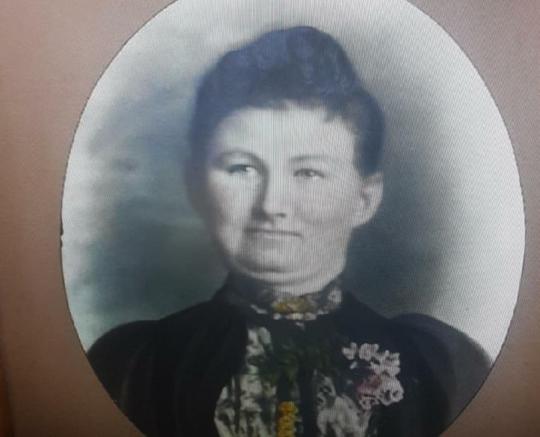
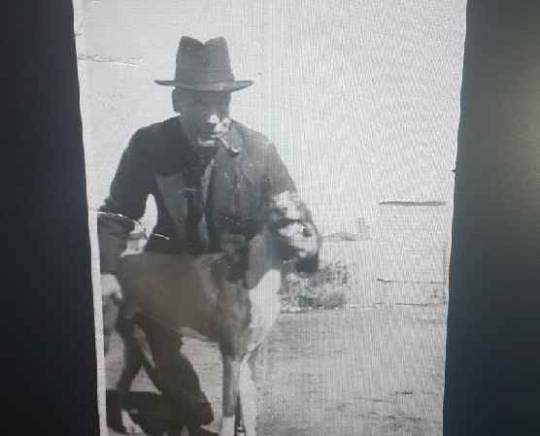
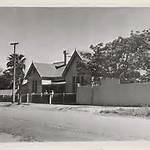


FINAL
Robert Sherriff
NOBODY’S HOME
In the Name of the Father.
Chapter One
My Father did not admit to having a past. The story of his early life was a mystery lost in his lack of words and an inability to expose anything that could be vulnerability, humanity or even kindness.
My mother would eventually and begrudgingly supply me a few details, but this only went on to provoke more questions. He was an enigma to the end; leaving no suicide note, no apology, and no peace for those who survived him. I am only certain of one thing. My father's hate for me was virulent.
The dynamic of the real family is rarely the all-encompassing love of the fairy tale or the softness of the detergent commercial, but my family was extreme by any standards. Violence was our currency, and the absence of genuine love left a void that was filled with darkness, betrayal, and humiliation. We were an Australian family and Australia was an uncompromising place in the sixties or at least that is how it appeared to me. We were told we were growing up in the lucky country. We were told we could achieve anything through hard work and spirit yet at the same time I was being brutalised and made to feel worthless by the people I loved the most.
It would happen at night. I was small for my age, a premature twin, the smallest to survive in Victoria at the time, I was easily carried out of the house and into the garden by someone of my father’s build. He would be drunk, clumsy, and rough. I would be hastily stripped. My clothes were torn from me, and I would have to stand defenceless and naked in the yard. I would have to take my chances. I would not wait to see if he would stop at the humiliation and spare me the violence, he never did. I would take advantage of his drunkenness and feel for his grip to loosen or slip and then I would go. I would run through the neighbourhood to escape the attack. Was I worried about the neighbours seeing me naked? Hardly, this had happened so many times before. I knew what it was to run barefoot on cracked bitumen that was baking from the day’s biting sun. I knew running naked in the near freezing winter nights too. I knew what it was like to be running for your life. I spent a childhood running the streets and I’ve spent a lifetime escaping my father.
My father was born in South Australia in 1929. He was the son of a prostitute and born out of wedlock. He must have not known his father in any meaningful way, but he will have had suspicions about the 100's of men who visited his mother's house. My father had inherited a large build, olive skin, deep brown eyes, and tremendous capacity for anger. My father’s hair and mood were black for his entire life.
The earliest photograph I have seen of my Father is him as a boy holding a black dog. He had a patience with animals that he was never able to show to people. He was tall and skinny with a mop of black hair. This child would develop into a man of six foot four with a powerful build clothed in skin scarred by the Australian sun. He was mutilated emotionally and carried a pain that could infect anyone in his vicinity. His hands would grow to be huge, always at least twice the size of mine yet he was quite graceful in his movements and well kept. He was clean shaven and took pride in his appearance. At home he dressed in casual jeans and shirt, and he insisted that they were clean and ironed which meant my mother would often discover lipstick stains on his collar. A fight would then ensue with the devil rising into those brown eyes and consuming the man.
My father's childhood was as fractured as any other part of his life. He would always be on the move, change jobs and locations and even personalities but his consistent companions were alcohol and misery. He was Christened Robert Sheriff, the same name he gave me. He left school early and worked a succession of tough, unskilled jobs. He was a station hand and a fruit picker and went from one manual labour to another building callouses and emotional hardness.
The one anecdote I know from his youth is an incident where he nearly drowned. At aged nine he was pulled from the water at Port Pirie. Pirie was and still is a small industrial town in the shadow of grain silos and a lead smelter, about a three-hour drive north of Adelaide where grain shipping and industry had called for unskilled immigrants to come and build a town. All of life in Pirie takes place with the backdrop of the smell of sulphur, a soft scent of hell from the lead smelting process. One day my father fell into the water that carried the grain ships and plunged toward oblivion in the waters that reflected the belching chimney stacks. A man walking past at the time saw my father fall and dived into the water to save him. The story made the local press where it describes my father's saviour as a hero. This stranger’s act has ensured thirty-five descendants, I exist because of him, my children and grandchildren, my great grandchildren, my sisters, my beloved twin brother were all offered a chance of life because my father did not drown that day, but I wonder if my father had any appreciation for his rescuer and those bitter and soulless years he lived until he decided to meet his maker at his own hands.
Though my father's history was patchy my memories of my own childhood are not. The site of his near death became significant for me as a young boy as he took me there to teach me how to swim. Father's lesson involved throwing me off the jetty with a grin on his face. I had sunk in the same waters he had, in the shadow of the same industrial chimneys in the run-off of the same toxic processes. I did not have a hero on the banks poised to save me. I would have to save myself. I had already learned by this stage that I would have to fight to survive him, and I swam for the surface and pulled myself out of the water to spite him repeatedly.
I have an image of my father, when he was outside the house, as a well-dressed man, a man who wore grey pants a white shirt and a two-tone brown and grey jacket that was considered respectable at that time. He was always drinking. He drank West End long necks at breakfast time. He had three cartons at home every week but that was nothing to what he drank in the pub. I think my mother had tried to get him to cut back once but she was never foolish enough to suggest it again.
Every image I can conjure of him has him glass in hand or glass to lips. People feared him. He dominated every space he entered and other people, even adults, were as affected as me. He had a dark energy; a belligerent nature and he would live life with a dangerous soundtrack of his beloved country music or loud rock and roll. Our house echoed with the sound of Johnny Cash and Hank Williams. It made me hate county music and I am only starting to get over my aversion now.
The neighbours were always scared of my Father. Wherever we lived he created an empire where his actions were uncriticised for fear of violence and retaliation. All our neighbours witnessed my humiliation plenty of times. They were scared to get involved and even if they witnessed with closed mouths they were greeted with a barrage of snarling and swearing. I know there was an ugly silence around our house and people were witness to horrific crimes without ever speaking up or intervening. I do not carry any resentment for those people. This was a time when men were masters in their own house. It was not uncommon for children or wives to be abused and the man to rape the wife then the abuser to meet the police sergeant in the hotel for a quiet word and a pint later. In the early sixties in Australia there were no safe houses, no campaigns against domestic violence and a belief that a family was a man's property.
I think there was only one occasion when an adult intervened on my behalf. He was called Mr. White and I remember that he always wore brown, was six feet six inches, around 240 pounds with blonde wavy hair and couple days of beard growth. He was solid as a shit house that used to be at the back of Auntie Blanche's and Uncle Albert's house. Mr. White was briefly my saviour, my man on the shore who saw my fall and dived in to save me. We lived on Hargrave Street in Northfield at the time and Mr. White was a neighbour who tired of my father's version of childcare and belted the crap out of him. The Police arrived just as he was walking due East and we never saw Mr White again.
This was a rare adult intervention on my behalf. An act of violence that did not teach my father a thing and did not save me from further abuse. As I have said I am not angry at the witnesses who did not come forward or the authorities that did not protect me. People knew right from wrong but unless you were Mr. White you were not armed enough to take my father on. Justice was only available to the physically strong and often my father was by far the strongest. My father was an advocate for the merits of physical strength. He hated my smallness, my frailness, and my inability to hurt the same way he could. He systematically set about to teach his children strength and suffering.
He would fill two buckets with water and tell me to stretch my arms out. I knew to do as I was told and despite knowing what was coming I would always do exactly as he asked. When my arms were out and steady, he would loop the bucket handles over my wrists and demand that I hold then there, straight for as long as I could. I would hold the buckets, my arms screaming with pain, desperate not to disappoint or spark the anger of my father. He would watch me and justify his actions with the defence that he was driving me to be healthier and more vigorous. This was the start of my father's torture, and it began when I was six years old.
I have other recollections of this early abuse. He had caught me swearing and decided to chastise me to teach me a lesson. He took me outside and removed my trousers and underwear. He then put me over his knee and beat me with a garden hose. The strokes were so violent that I was left with blue and red strokes over my backside and sitting down was impossible for the coming week. These memories are vague and without detail, but I recognise them as the start of patterns of abuse that would culminate in broken bones, emotional damage, and a world of hate that not everyone would survive.
My mother met my father in 1952. He was working for the RAAF, and she told me it was love at first sight. I believe that she did love him before they were married, in that moment when he first arrived in her life and before she really knew him. He was tall and good looking. Her family had been extremely strict whilst his upbringing was wild and libertarian. She must have seen him as a glamorous escape. In 1953 they married. She told me that all his mates came, and he joined them in getting very drunk. She was appalled but she must had known that alcohol and my father were synonymous by then. His heritage was beer soaked with his mother being a heavy drinker and the addictive gene being passed onto me. I wonder if she knew how tormented her new, young husband was. I wonder what sort of life she had dreamed of and if she thought that my father could bring her happiness. She could never have known she would die with her husband lost to suicide and her family absent from her bedside.
My Father was twenty-four years old when my brother Peter and I were born. My mother recalled that he was upset by the drive to the hospital to see his new sons. It had been an inconvenience to come to visit and he was happy for her to know it.
I cannot remember much of those early years at home with my mother and brother but that is no reason to assume they were comfortable or without incident. My father would often remind me that he had hated me from my birth. He told me that he wished I had never been born or had died in childbirth on many occasions and it was like I had been born into his hatred and lived there my whole life. His insult to me was that I was 'stupid.' He would use that insult for my entire childhood, and it did the damage he required.
My father's need for destruction was always going to end with his own. We were just lucky he could not take us with him. He had been known to come home drunk with a can of petrol and threaten to set himself, the house and us alight. His pain was not a personal matter but something everyone else had to pay for. At night I would lie awake waiting for him to come home. I was terrified by the cast of the streetlight outside my room. It would reflect in the dark of his eyes if he came into my room. It would make him look like the demon he was and convince me that this small industrial town was a corner of hell.
He would stalk around the house brooding over something that happened that day, last week, a month ago or not even at all. He would look for his target. My mother, my brother, my sister, or me. Then he would punish, seek vengeance. All his misery and hatred and disappointment would be played out on his victim. Often, I was that victim, the focus for his spite. Everyone was terrified of this man, and I became a scapegoat. My Father once told me he was more frightened of me than I should be of him. Perhaps therefore he reserved a special hatred for me. I can remember his hand around my throat. His thumb on my Adam's apple.
“Four or five seconds of pressure is all it will take.” He would say. Perhaps he was promising to end my pain as well as his.
I know my mother blamed me for things she did. She stole money and blamed me. She even buried two thousand dollars in the garden once and Dad went over it with the lawn mower. She laid the responsibility with me. She was just trying to avoid another rape or beating.
And so, the violence continued. We moved around Australia taking my father's misery and torture with us. I was beaten by my father at the pie-cart. I was beaten by him in the street. I was beaten at home. Fists and abuse were the landscape of my childhood as much as the hot dry summers and crabbing down at the jetty. Days out with my father were tours of the hotels or waiting in the car outside a brothel. Every lesson I learned under his tuition was self-destructive and selfish. The irony was that I still loved that man. He was my father, and I was his son. It would take a particularly brutal assault to give me any chance of escape and once again my rescuers would not be hauling me out of the water but dragging me further under. I would not be able to take a breath for some while.
2 notes
·
View notes